
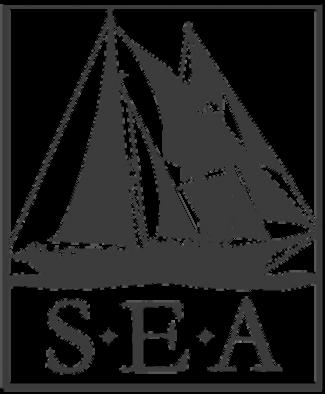
ISSUE 2, 2023 TheConservationandHealth oftheCentralPacificOcean
SEA Writer
Light green=Exclusive Economic Zone (200 nautical miles from coast)
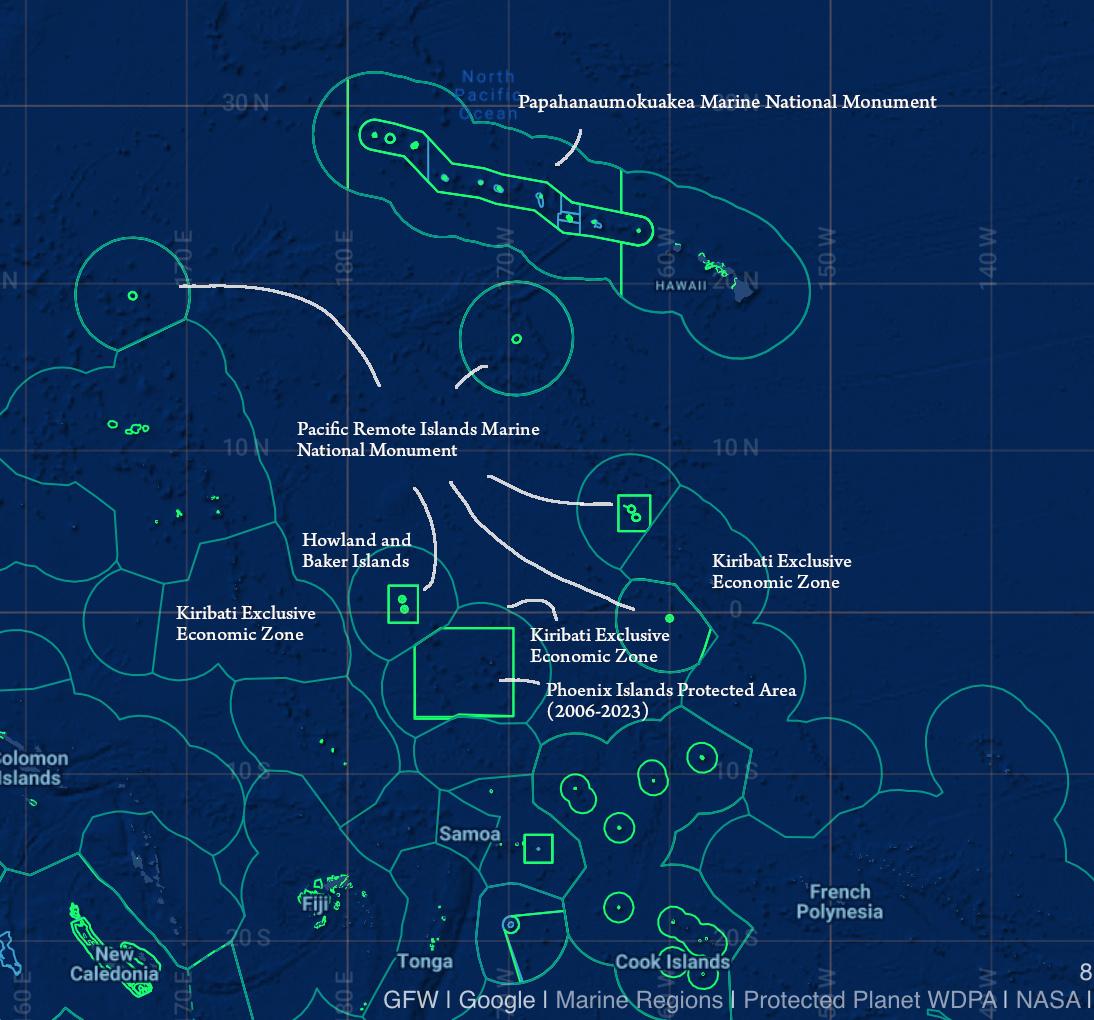
Bright green=Marine Protected Areas
Map adapted from Global Fishing Watch
- -
Introduction
S’310 Mission and Ethics Statement
“Oceanographic Overview”
"A Passage Through the Torrid Zone”
"Carbon Dioxide Fugacity and Ocean Acidification: A Silent but Deadly Threat"
"Teaching Climate Change in the Midst of Catastrophe"
"Who Holds the Steer?"
"The Forgotten Realm’s Dilemma: Deep Sea Mining"
"Energizing the Pacific Islands"
"Shifting Blue"
"Beyond the Goop: Tuna Larvae and the Pursuit of Sustainable Fishing"
"If I Were a Fish, My Dying Wish: You’d Count Me"
"The Shark Unfinned: That State of Global Shark Populations"
"Connecting New England to the Pacific through Sperm Whales"
“Seabirds in the Central Pacific”
"Life Lessons from a Booby"
"How to treat Marine Invasive Species like a Doctor"
"Plastic in the Pacific: From the Depths of the Ocean to Shores Seen By A Few"
"What We Can Do about the Health of the Central Pacific Ocean?"
Contents
Coda Biographies Voyage Map 4–6 7–8 9–10 11–14 16–20 22–28 29–34 36–40 42–46 48–50 52–56 58–61 63–67 69–73 74–77 78–81 83–88 90–92 93 94–95 96–98 99
The Sea Education Association (SEA), based in Woods Hole, MA, USA, offers ocean studies programs for undergraduate, gap year, and high school students
Introduction
On the 7th of June 2023, only the second full day in Woods Hole for the students of class S’310, the Ambassador to the United States from the Republic of Kiribati walked into the classroom. Although Mr. Teburoro Tito, who was also the former president of Kiribati, was wearing a tie and jacket, his demeanor and tone put the students immediately at ease. The meeting felt more like “a hang-out with a distant relative,” as student Sam Barresi put it. Ambassador Tito sang traditional songs from Kiribati but also had a sing along with a John Denver tune Student Julius Gabelberger presented him with a signed homemade card from everyone, adorned with a painting of a frigatebird, the national bird of his country, and before he was whisked off for various other tours around the campus and on board one of SEA’s ships, the Ambassador managed to make us all feel that our oceanographic research was important and useful that the voyage ahead had a meaning larger than ourselves
We were spending three weeks in Woods Hole in preparation for a six-week voyage at sea. The students met the SSV Robert C. Seamans in Honolulu, where aboard was a full staff of scientists, visiting scientists, watch officers, deckhands, and other academic and professional maritime crewmembers, totalling thirty-three people.
The plan had been to visit the Phoenix Islands Marine Protected
ISSUE 2, 2023 cont'd >
Area (PIPA), where we hoped to continue our baseline research oceanographic and ecological conditions, just as we had done nearly every summer since 2014, sending our data to the PIPA office in Tarawa and to other partners. But by the time Ambassador Tito came to Woods Hole, we all knew that PIPA was no longer a marine reserve Political winds and financial needs had shifted back home. Fishing vessels had been let back into the region.
To a new department in the government of Kiribati, SEA had entered a new permit to request permission to conduct research. This permit still active even as we left the dock and began sailing south from Oahu, but in the end we could not get an observer on board in time, so we changed our cruise track to go just to the north, to the marine protected area that borders PIPA, the portion of the Remote Pacific Islands Marine National Monument (PRIMNM) that extends out from Howland and Baker Islands The PRIMNM was first established in 2009, then expanded in 2014. This portion of the PRIMNM is managed by the United States Fish and Wildlife Service, who gave us permission to sample within the monument’s waters, up to three miles from the shore of these tiny islands, these low tips of sea mounts that tumble steeply down more than 3,000 meters beneath the surface.
Though we were disappointed to
not visit the waters of Kiribati and meet the people stationed on Kanton Island, the waters around Howland and Baker, known as the American Phoenix Islands, are no less fascinating oceanographically, historically, and in terms of current management. This region offers data on the characteristics of marine protected area waters around equatorial sea mounts. And we knew we were learning in real time about geopolitical interactions with marine conservation. We respect the sovereignty and goals of Kiribati, a relatively new government, regaining independence in 1979 a nation whose territorial waters stretch across the equator a similar distance to the width of the United States.
So we sailed and sampled in US waters, sweated below, hauled on lines, cooked, cleaned, and sweat some more under the equatorial sun. As we sailed south toward Fiji, we analyzed our data, and after five weeks and over 4, 200 miles, we dropped our anchor off Savusavu Harbor in Fiji.
Throughout the trip, we continued our efforts to learn about the oceanographic and ecological health of the central Pacific Ocean, the current management of these waters, and about the people who have lived and moved through these vast waters for well over a thousand years Kiribati, along with several other low-lying nations in the Pacific and other parts of the world, are on the very front lines of climate change.
cont'd >
Although the I-Kiribati people had nothing to do with the creation of the problem, global warming is currently killing their reefs and sea level rise is inundating their shores and spoiling their already scant freshwater resources.
This magazine, this special issue of SEA Writer, focuses on the health and management of the Central Pacific This issue is an interdisciplinary reflection of some of our studies, both on shore and at sea.
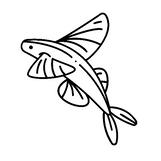
Ambassador Tito told us that “Any human-made mess must have a human made fix.” If he can stay positive and keep working, we can, too.
On Monday July 31st, a rainy afternoon hundreds of miles from any land, we gathered in the salon of the Robert C Seamans and tried to build consensus on what we could do the result of which is at the end of the magazine.
We thank you for reading.
This summer's SEA Semester, class S'310, aboard the SSV Robert C. Seamans involved three weeks of preparation in Woods Hole, MA, then a six week sail from Hawai'i to Fiji via the Pacific Remote Islands Marine National Monument. Undergraduate students took classes in 'Oceanography' and 'Conservation and Management.'
Cover art: Julius Gabelberger
Collage Art and Voyage Map: Hannah Gerrish
Original Canva Template: Zuzanna Witek
Editors: Mallory Hoffbeck and Richard King
Captain: Rick Miller
Chief Scientist: Blaire Umhau
S’310 Mission and Ethics Statement
In Woods Hole we collectively drafted the below, which Autumn Crow consolidated, and then we revised. It’s a document we revisited while at sea, and it was posted on the bulletin board in our ship’s library

We, SEA Class S-310, aim to conduct ourselves ethically throughout our time from Hawai'i to Fiji and potentially through the Phoenix Islands Protected Area and everywhere in between through our work and travels as students, researchers, and tourists. In order to maintain the highest standards of ethical conduct, we will adhere, to the best of our abilities, to the following standards:
As students, we will try to:
Recognize the importance of ethical behavior, and actively seek to acquire the knowledge and skills necessary to embody it.
Continuously challenge our assumptions, evaluate our perspectives, and remain openi d d t di d i d ti
As researchers, we will try to:
Report our findings accurately and conduct unbiased research honestly as we try to identify our potential conscious and unconscious biases.
Recognize the broader benefits of our baseline data, as well as our individual study
ISSUE 2, 2023 cont'd >
S’310 students, SEA staff, and Professor Randi Rotjan (teal sweater) with Ambassador Teburoro Tito (tie)
Attempt to mitigate any ambiguity in our data to prevent future misuse and misinterpretation
Share our data with the local communities of the area we are studying. (For this cruise the full report will go to Kiribati partners after the trip, and then we will first check with all other research collaborators regarding the sharing of our data for this cruise We’ll put clear instructions on how to contact us in our magazine, considering F.A.I.R. use principles, as discussed in Proulx, et al, 2021, in our C&M reader, for anyone who wants access to our findings.)
Recognize the historical and present-day use of science as a tool of oppression by some and actively work to address it.
Evaluate the potential and actual harm of our research, and take steps to minimize any negative impacts
Understand and mitigate the environmental consequences associated with data collection. Learn and incorporate native names for flora and fauna we encounter, whenever possible
As tourists, at sea and on land, we will try to:
Leave every place we visit better than we found it
Show respect for the land and sea, recognizing our place within the natural environment
Acknowledge the central role of the sea in our journey, studies, and the broader purposes it serves beyond our own
Recognize the privilege we have to travel through the Pacific, and acknowledge that our presence is not an inherent right, just as it is not our inherent right to acquire local knowledge in this region or to conduct research.
Have fun and enjoy ourselves as a way to celebrate the gifts of this voyage and this place!
Oceanographic Overview
S
SV Robert C. Seamans
sailed from Honolulu, Hawai’i to Denerau, Fiji from June 23rd through August 8th, 2023 Along the way, data were collected across a range of biogeographic zones, beginning in the subtropical equatorial Pacific south of Hawai’i, moving into the equatorial current system and ending with high resolution sampling on the eastern and western sides of the chain of seamounts straddling the equator that includes Howland and Baker Islands. These islands are part of the Pacific Remote Islands Marine National Monument (PRIMNM) and are both designated as wildlife refuges While they are governed by the United States, Howland and Baker Islands are considered part of the Phoenix Islands group, most of which is governed by the Republic of Kiribati Scientific sampling ended once leaving the chain of seamounts, and the ship continued sailing south to the final port of Denerau, Fiji.
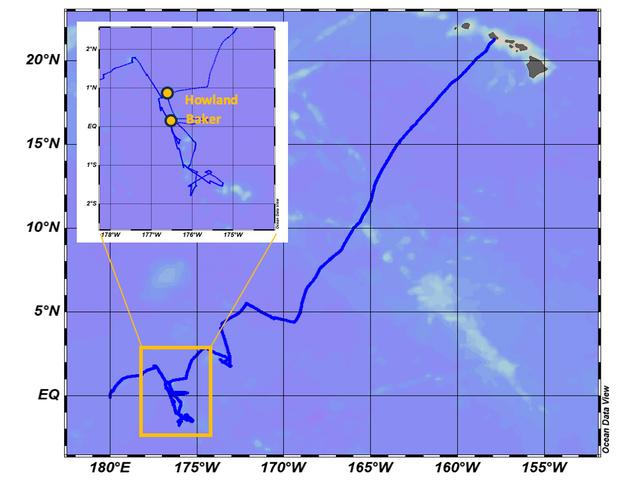 by Blaire Umhau
by Blaire Umhau
This six-week cruise contributed to a bank of data on upper ocean plankton populations and supporting physical and chemical parameters. Data were also collected that may provide insight to pelagic ecosystems surrounding seamounts Samples collected within the boundary waters of Howland and Baker Wildlife Refuges provide a unique record of marine ecology in areas with limited anthropogenic
cont'd >
ISSUE 2, 2023
Track of scientific sample collection for cruise S’310 Inset shows the locations of Howland and Baker Islands
Hawai’i
influence, as these islands are uninhabited and strongly protected from anthropogenic activity by the US Department of Fish and Wildlife.
Seafloor bathymetry, current velocity, sea surface salinity, sea surface temperature surface in-vivo chlorophyll fluorescence data were collected continuously along the cruise track.
Vertical water column profiles were collected using a carousel equipped with twelve two-liter Niskin bottles and sensors for dissolved oxygen, photosynthetically available radiation , in-vivo chlorophyll-a, and conductivity, temperature, and depth. Discrete water samples were collected and analyzed for pH, total alkalinity (TA) and chlorophyll-a.
Phytoplankton samples were collected daily using a small drift net Zooplankton and micronekton (tiny fish and squid) samples were collected during daytime and nighttime stations using a neuston net for samples from the surface layer and a tucker trawl for samples from the surface down to a depth of 100 m. During daylight hours, data on seabirds were collected using hourly observations.
Student projects using this set of data focused on bathymetry comparisons between observed and published data, the distribution of pH, alkalinity and dissolved CO2 concentrations, phytoplankton
by Blaire Umhau
abundance and community composition, zooplankton abundance and community composition, and seabird abundance, community composition and behavior.
Further Reading
and the Data from this S’310 Cruise
Blaire P Umhau, “Final Report for S E A Cruise S310” (2023): Sea Education Association, P O Box 6, Woods Hole, MA 02543, USA.

To obtain this report for free or see the unpublished data, contact Blaire Umhau (bpumhau@gmail.com) or the SEA Data
Archivist:
Data Archivist
Sea Education Association
P O Box 6
Woods Hole, MA 02543 USA
Phone: 508-540-3954
Fax: 508-457-4673
E-mail: data archive@sea.edu
Web: www.sea.edu
A Passage through the Torrid Zone
hat’s the image you have after reading the title? Centuries ago, when Europeans were expanding their exploration of the world on sailing ships, they experienced the increasing temperatures as they sailed south, determining eventually that the heat would prevent passage. This was called the Torrid Zone. Would your image be different if the title was “Sailing through the
WTropics”? The Torrid Zone and the Tropics share a common definition today, the area between the Tropic of Cancer and the Tropic of Capricorn. This is the area where solar radiation meets perpendicular to the earth’s surface creating the most intense heating of earth. Compare this to the polar regions where the sun’s solar radiation encounters the earth’s surface at a relatively small angle, spreading its heating effect over a large area. Think of a flashlight aimed directly at a wall (a focused circle of light)
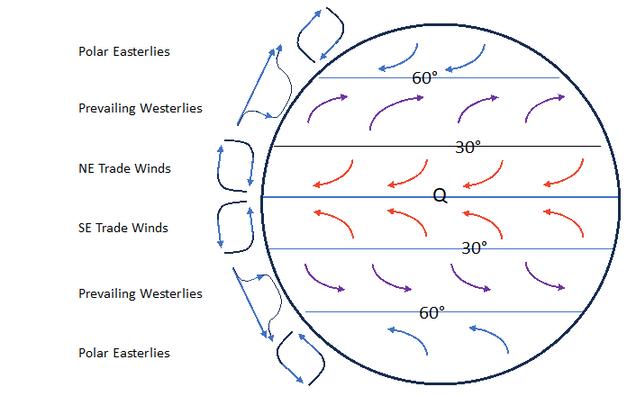 by Rick Miller
by Rick Miller
cont'd >
ISSUE 2, 2023
compared to holding the flashlight at a small angle to the wall (its light spread in a large cone shaped pattern). Due to the tilt of the earth’s axis relative to the plane of its orbit around the sun, that perpendicular encounter to the earth’s surface shifts between 23 1/2° north to 23 1/2° south each year. This is what defines the tropics (and the Torrid Zone)
The Torrid Zone is part of a trio of zones, bordering the Temperate Zone, followed by the Frigid Zone. Respectively, the Tropics too are part of a trio, associated with the Mid-latitudes and the Polar region. The varied angle of encounter of solar radiation heats the earth and its atmosphere differently at different latitudes. The atmosphere is always seeking a balance, a common temperature. This is what creates our winds and our weather! A global model provides a visual representation of what happens as the atmosphere tries to balance the heat of the tropic with the cold of the polar regions.
The Global Circulation Model

In the model above the curved arrows inside the circle (the globe) represent surface winds. The arrows outside the circle show the vertical motion of air movement as well as the upper air wind direction. This is a continuous cyclical pattern, so there is no specific starting point,
by Rick Miller
but the equator (Q) will be the initial reference. Air at the equator is hot and humid, it is also forced to rise due to converging winds (see the red arrows) as well as being hotter than surrounding air. Rising air creates low pressure at the surface The equatorial region is a belt of low
pressure. As any air rises, it expands (less pressure) and cools The cooler air cannot hold as much water vapor, so condensation occurs forming clouds. The equatorial area receives ample rain throughout the year. The equatorial air that has risen moves north or south toward the poles to cool off The Coriolis Effect turns those upper air winds (right in the Northern Hemisphere, left in the Southern) resulting in a ‘pile up’ of upper air around 30° N or S. As the air piles up, it gets heavy and falls (subsides) to the surface. The upper air is very dry having lost most of its water vapor to cloud development at the equator. As the air falls, it is compressed (greater pressure) and warms more. The falling air creates a
cont'd >
The atmosphere is always seeking a balance, a common temperature. This is what creates our winds and our weather.
band of high pressure in this belt known as the Sub-tropical High (or Horse Latitudes). The arid desserts on earth all are found in this region The air falling and hitting the surface must now spread out, some moving north, some south. The air moving toward the equator is turned by the Coriolis Effect resulting in the northeast or southeast trade winds (red arrows). The trade winds blow very consistently throughout the year. There is little to disrupt this pattern. The meeting of the northeast and southeast trade windscreates the convergence referenced above. This is called the inter-tropical convergence zone (ITCZ).
For reference, there is another convergence zone near 60° N or S where the prevailing westerlies meet
by Rick Miller
the polar easterlies. This convergence is known as the polar front and is very different than the ITCZ. At the polar front the winds are converging in opposite directions (westerly/easterly). The westerlies are typically warm and humid while the easterlies are cold and dry! This too is an area of ample rainfall, but also the area where low pressure cyclones are formed. These lowpressure areas, familiar in the midlatitudes, disrupt the prevailing winds regularly and create the ever changing weather in this region.
The cruise track for the SSV Robert C Seamans and the crew of S’310 “Protecting the Phoenix Islands” departed from Honolulu, HI, sailed to the US Phoenix Islands (Howland and Baker Islands) where cont'd >
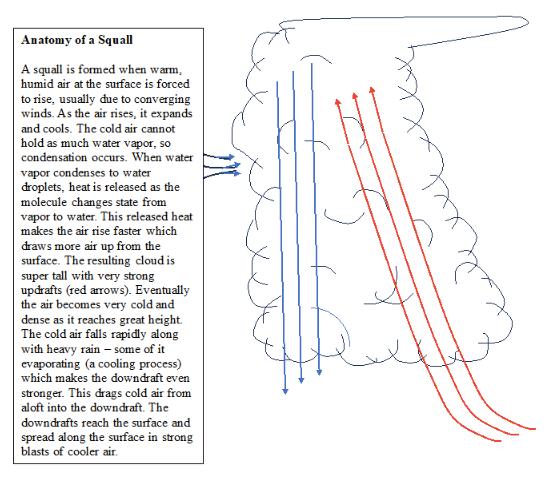
focused data collection took place before continuing on to Port Denarau, Fiji. Honolulu is located near 20°N latitude while Port Denarau is near 18°S latitude. Our passage was in the Torrid Zone! Overall, this made for good sailing, with consistent easterly winds driving our ship south The trade winds, both northeast and southeast, provided the winds that allowed us to sail the 4,600 nautical miles through the tropics.
Our research took place in the US Exclusive Economic Zone (EEZ), a two-hundred-mile radius of territorial waters surrounding Howland and Baker Islands. A special permit allowed us to enter the Marine Monument, a defined protected area around Howland and Baker Islands. Our research plan had the Robert C Seamans zig-zagging north and south, deploying science equipment twice each day – morning and night. Data collection was intentionally positioned on the “upstream and downstream” sides of a chain of sea mounts (underwater mountain range!) which also included Howland and Baker Islands. It was here doing research where the ship first crossed the equator! Howland and Baker Islands are located near 2°N to 4°N latitude Sailing here in July for over two weeks the ship and crew were located at the ITCZ. The Intertropical Convergence Zone produces
 by Rick Miller
by Rick Miller
frequent ‘squalls,’ small to large cumulonimbus clouds that can bring strong wind, heavy rain, and occasionally lightning. This region was also HOT! and was the inspiration for the article title. The crew did a great job maintaining a vigilant eye for weather and were ready to reduce our sail area whenever a larger squall threatened high winds. The rain was often a relief from the hot sun and there were a couple of fortunate days with little wind that allowed the ship to “heave to’ for a swim call in midPacific!
That’s a quick overview of our passage weather! The reliable trade winds and the ITCZ. As the cruise approached Fiji the ship encountered its first front, where warm air met cooler air from the south. The equatorial temperatures dropped noticably as we comfortably sailed to Savusavu where the ship and crew cleared customs and immigration and enjoyed a short visit before reaching the final port near Nadi, Fiji

"Carbon Dioxide Fugacity and Ocean Acidification: A Silent but Deadly Threat"
y absolute favorite aspect of this journey, traveling across the Pacific Ocean from Honolulu, Hawai’i to Nadi, Fiji on the Robert C. Seamans, was my time spent in the laboratory. Students and deckhands were allotted time during the watch rotations to gather, process, and analyze data for several unique research projects My project was shared with my partner Hallie Rockcress. We collected water samples at multiple water depths twice per day and processed for pH, total alkalinity (the water sample’s ability to resist pH changes), and chlorophyll-a With the pH and total alkalinity values, we could calculate the carbon dioxide partial pressure (the concentration of carbon dioxide in the water). We also compared the fugacity of CO2 to the deep chlorophyll maximum. That’s the point at which there is an abundance of chlorophyll in the water column, which normally indicates activity
by Olivia Patrinicola
Mfrom phytoplankton. This project is incredibly important to my partner and I, and we hope to add to the general knowledge of the chemistry of the equatorial Pacific Ocean.
As we stumbled from one side of the lab to the other as the boat rocked back and forth, we continued to learn more about the pH of the waters that we sailed through. I had become more and more invested into the issue with every sample processed. While pH levels may seem better here due to our close proximity to the equator, it took an
 cont'd
cont'd
>
ISSUE 2, 2023
Hallie and Olivia hard at work gathering water samples from the carousel (Hannah Gerrish)
immense amount of effort, time, and people to gather all of the data used for our research project. It put climate change scientific research into perspective, especially with how much it will truly take to create change, and how the acidification of the seas requires the help of everyone to turn things around
For the past thirty years, there has been increased activism and policy making to work against climate change. But we must ask ourselves if we are truly doing enough. The root of the issue within our seas is decreasing pH levels caused by temperature fluctuations
atmosphere. Currently, average pH levels around the world are between 8.0 to 8.3, which, depending where on the globe you are, is considered healthy enough to support marine life. If we continue to create carbon emissions at our current rate, and even faster, according to the 2022 IPCC report, the pH will likely slip below 8.0 and the degradation of life under the sea will occur exponentially. The US Ocean Climate Action Plan predicts that at this rate the planet will reach two degrees Celsius of warming by 2100. A large effect of ocean acidification is the dissolution of calcium carbonate
globally. This is something that affects the core chemistry of the seas and cannot just be relieved with light policy. According to a 2019 study by Harrould-Kolieb and Hoegh-Guldberg, the seas are now twenty-six percent more acidic than they were since before the Industrial Revolution. The oceans also act as a carbon dioxide sink, which means that it absorbs CO2 from the
 by Olivia Patrinicola
by Olivia Patrinicola
shells. When the calcium carbonate bonds break from the added carbon dioxide, organisms such as bivalves and coral experience structural weakness, which normally leads to death of the organism. Due to anthropogenic ocean acidification, coral reefs have experienced extensive damage and death, which has resulted in mass habitat loss for organisms who rely on reef
cont'd >
Calcium carbonate shell dissolution as an effect of ocean acidification (Image adapted from David Littschwager/ National Geographic Stock)
ecosystems

The United States released their Climate Ocean Action Plan this past March 2023, which includes several sections that review ocean acidification. I believe this is a success and will lead towards more success, as it is one of the first occasions that ocean acidification is included in the conversation when discussing climate change in general US governmental reports. The plan is useful because there is a scientific version, and a much simpler version online. The simpler version is aimed
need to get on the problem is something the plan focuses on, which is a newer development in the United States. Some of the other aspects of the document include the promise of a physical plan in the next coming months, increased data collection and scientific efforts, forming resilience for coastal and stakeholder communities, mitigation efforts, and including ocean acidification in the conversation for geoengineering projects The plan goes as far as mentioning that ocean acidification is a high priority in the list of climate change related issues and that an additional Ocean Acidification Plan will be released in this year.
to educate those who do not know anything about ocean acidification, which is currently very common, even in the climate action world. The official version of the Action Plan covers detailed aspects, while the other contains more accessible information The authors state, “Many of the species that are at risk have high commercial, cultural, and biodiversity value, lending urgency to the need to reduce ocean acidification.” Emphasizing the dire
by Olivia Patrinicola
A global effort similar to the US action plan is the International Panel on Climate Change, or IPCC. This is a gathering of scientists of a multitude of educational backgrounds around the world that form a regular report on the climate situation. It covers every corner of climate change that can be studied and explored. The most recent report was released in 2022 and is now the 6th report the IPCC has released. The report is hundreds of pages long and mentions the effects of climate change on a scientific level. The panel is not allowed to form policy, only create suggestions. The IPCC reports have not always mentioned ocean acidification and how directly it relates to climate change, but the
cont'd >
The first step to helping the seas maintain a viable pH level is by remaining educated and up to date on what is going on around the globe.
more recent reports, especially the 2022 report, extensively describe ocean acidification and its damaging effects to the planet. Unfortunately, with the IPCC’s inability to physically do anything besides release their report, some argue that it isn’t that useful in tackling climate change.
In addition to the US Climate Ocean Action Plan and the IPCC reports, the United Nations has formed several efforts over the past thirty years in the form of agreements, to boost climate change action The most recent, the Paris Agreement (2015), only slightly covers ocean acidification. The issue with the United Nations Framework Convention on Climate Change (UNFCCC) is that these agreements do not hold any country accountable. The promises representatives make can only be monitored for improvement and implementation, but those who choose to be in the agreement are not bound by any law. The US, for example, pulled out of the Paris Agreement during the Trump Administration and later re-entered the Paris Agreement during the Biden Administration. Yet these protocols and agreements made under the UN are still useful to increase awareness and stimulate action without force.
As we saw a bit of Fiji during the last few days of our tremendous
journey, I reflected on what the future could potentially hold for these ecosystems. The truth is that these diverse fish cities will die out from coral bleaching as the ocean continues to acidify. It is an issue that needs to be tackled immediately and should be of the highest priority. Because of the late addition of ocean acidification in the conversation, it is an aspect not thought about before and needs quick initiation. For example, the anthology compiled by Bill McKibben called The Global Warming Reader- A Century of Writing About Climate Change, gathers articles from 1896 to 1995 that cover global warming over the years. In the earlier scientific documents, ocean acidification is never mentioned, proving that ocean acidification is a newer point of conversation Many plans and policies have been made that focus on carbon emissions around the globe, several are covered in the agreements, plans, and reports addressed above
I encourage readers to further explore the readings below on ocean acidification, policy, and climate change. The first step to helping the seas maintain a viable pH level is by remaining educated and up to date on what is going on around the globe. Reading the IPCC reports, keeping up with Climate Action Plan developments released by the cont'd >
by Olivia Patrinicola
United States government, and supporting smaller climate action organizations, are all proactive methods to staying informed.
by Olivia Patrinicola
Further Reading
Harrould-Kolieb and Hoegh-Guldberg, “A Governing Framework for International Ocean Acidification Policy” Marine Policy 102 (April, 2019): pp. 10-20.

US Ocean Policy Committee, Ocean Climate Action Plan (United States: The White House, March 2023): https://www.whitehouse.gov/wpcontent/uploads/2023/03/Ocean-ClimateAction-Plan Final pdf
IPCC, International Panel on Climate Change (2022): https://www ipcc ch/report/ar6/syr/
United Nations, Paris Agreement, United Nations Framework Convention on Climate Change (2015): https://unfccc int/process-andmeetings/the-paris-agreement
Bill McKibben, ed. The Global Warming Reader- A Century of Writing about Climate Change (London: Penguin Books, 2012)
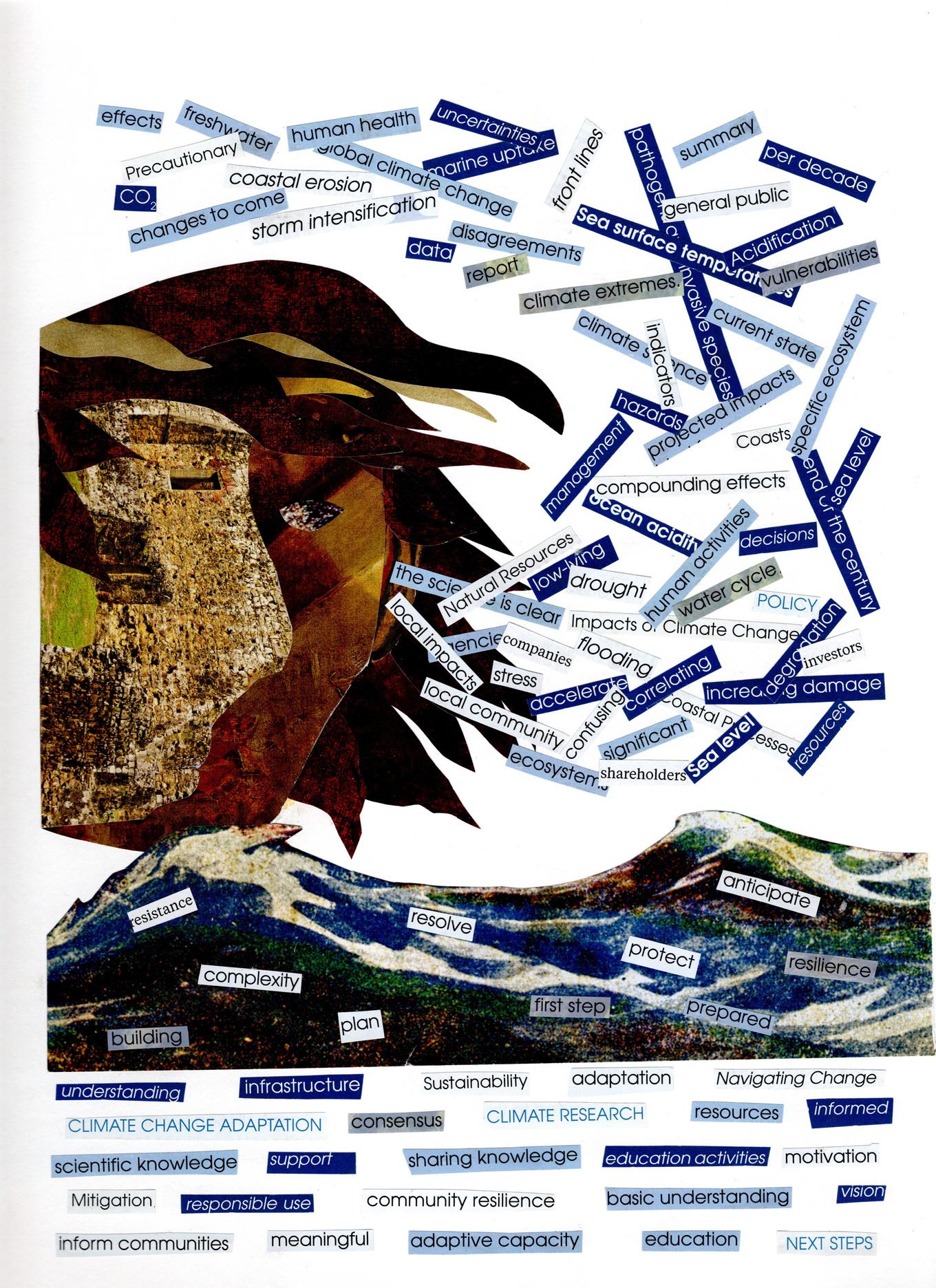
Teaching Climate Change in the Midst of Catastrophe
hen surrounded by water, the whole ocean changes with the sight of land. As Howland Island appears on the horizon as a tiny white strip, the ocean suddenly turns from an endless, infinite, blue space to a finite space with perceptible edges. In the infinity that is the ocean, when there is only blue on all sides, it’s difficult to picture the ocean rising It’s hard to imagine sea level rising as the ocean itself constantly shifts, rolls, and waves. Despite the obliviousness to change as I move constantly on the Robert C. Seamans, the ocean is rising. Thousands of islands are in danger, particularly within the Pacific Ocean as sea level rise could near one meter, coinciding with a potential global increase of 3 C°, by the end of the century.
As Howland peeks above the horizon, the gravity of sea level rise becomes evident Howland sits six meters above sea level. A few
meters of sea level rise will drastically alter the geography of Howland. As an uninhabited island, one could argue (though I will not) that there is a lesser reason for concern. But what about Fiji, Nauru, the Cook Islands, and more in the Pacific Ocean and others across the world that host whole populations? It’s projected 150 million people could live below sea level by 2050 Sea level for islands in the Pacific as well as the many other places that will be impacted, has the potential to be completely catastrophic to their way of life.
In the face of this catastrophe and dire consequences, education will be central to mitigate climate change and associated sea level rise. So how can K-12 teachers, specifically in the United States, effectively educate the youth about sea level rise and climate change as a whole, regardless of their students’ proximity to the ocean? How can students meaningfully learn about sea level rise in oceans thousands of miles away? As we consider broader implications of climate change, how
cont'd >
W
by Autumn Crow ISSUE 2, 2023
can teachers inspire stewards of the earth and promote proenvironmental behavior in students?
How do we teach about climate change and sea level rise in the midst of catastrophe?
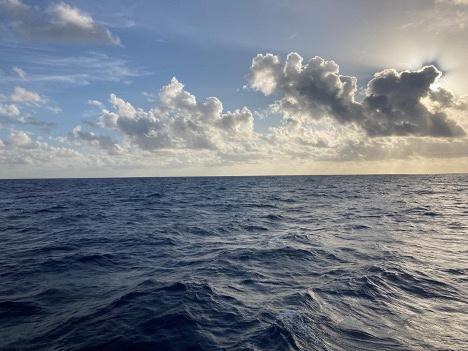
Talking and teaching about climate change is a precarious activity. Though various research shows benefits to both optimistic and pessimistic climate change narratives, climate anxiety and hopelessness are very real and everincreasing feelings that can be pervasive in the face of learning about imminent climate change. For teachers of any age level, from K-12 to university students, climate change can be a heavy and sensitive subject. Though we like to shield our
by Autumn Crow
younger students from harm and harmful ideas, it is imperative that our youngest students learn about climate change and start doing so from an early age. Though it is easy to get carried away with doom and gloom, it is important to expose our students to both climate change optimism and pessimism. Since both narratives have a role in creating pro-environmental behavior, how can we provide healthy doses of both to our students, while tailoring our education to the ages, cultures, locations, and more of those we are teaching? How can we create spaces for our youngest children to learn about climate change safely but effectively at an age-appropriate level? It’s impossible to provide
cont'd >
W
The great endless blue of the Pacific Ocean July 28th, 2023 at 5°56 0’ S x 179°17 1’
satisfactory answers to all the above questions, but below we’ll attempt to answer what we can in how to prepare our students in the fight against climate change and sea level rise.
Ages 0-6
Even before traditionally schoolaged, children should be learning about climate change. Though not in traditional schools yet, many children spend time in daycares and attend in preschool programs prior to enrolling in public kindergartens. Early childhood educators have a pivotal role in introducing youth to the environment and fostering unwavering love for the Earth and the environment as a whole. This comes from experience and exposure. For our youngest learners who have accessibility to nature, kids should be in nature as much as possible. It is important to note there are broader socioeconomic and cultural implications as to who has access (both temporally and spatially) to green spaces and those who do not, but the US should continue to strive to enable all kids and families free and easy access to natural spaces. For rural and suburban communities, students may have ready access to natural spaces, large or small. Bigger field trips and outings can introduce students to national parks, preserves, green spaces, coastal areas, and more. But natural
by Autumn Crow
exposure should not be reserved for special occasions, larger trips, and those in urban/suburban environments Educators of our youngest learners should endeavor to incorporate the natural world as much as possible, with visits to parks, playgrounds, and outdoor school yards. Exposure to nature needn’t be exhaustive or exhausting for teachers and care providers of young children. Creating space for students to be outside and notice things in the world is a significant start in climate change education for our youngest learners by exposing them to the outdoors that surround them.
Ages 6-12
Once students are traditionally school-aged, schools become a larger socializing force for youth. Students first encounter the formal opportunity to learn about climate change At this age, it is important that students begin to learn the science of climate change to establish a correct and comprehensive understanding. Of course, it

cont'd >
Creating space for students to be outside and notice things in the world is a significant start in climate change education.
is pertinent to design curriculum that is conceptually appropriate for students through these ages. In addition to introducing the scientific basis of climate change, this age of students is also suited to emphasize climate change solutions. Emphasizing solutions, whether potential or current, can balance the negative messages often infused in discussion of climate change catastrophe. Despite popular messaging, there are solutions to climate change and positive steps being introduced throughout the world Similarly, through personal action, students can feel empowered to devise their own solutions and contribute to positive actions on climate change. Whether as a class or as individuals, students can devise their own projects to make a positive impact on the environment even if not directly related to climate change, such as picking up litter, using less water, and talking with their family about their impact.
Ages 12-14
As students grow older, climate change education can shift to discussion involving students’ thoughts and opinions as well as opportunity for further selfexpression Discussion can allow students to ask questions, demonstrate interest, and explore areas of their own interest. Furthermore, with advancing studies and schools that begin to departmentalize, it’s
by Autumn Crow
important to know that climate change education cannot and should not be constrained to physical science courses like earth science and environmental science. Self-expression is a way to incorporate climate change material into other disciplines, such as through art. Whether through visual, performance, or written art, students can be provided the opportunity to express their own opinions, thoughts, and ideas in ways that help them to process big emotions and ideas. Beyond expression, non-physical science disciplines can incorporate learning about climate change through activities such as reading literature, watching movies, and completing self-designed research projects.
Ages 15-18
In the final grade levels of K-12 education, students reach a space where they are capable of complex, multi-faceted thought and problem solving as well as continual development and refining of their own opinions. This age group provides opportunities for educators and other adults to learn from students in unique and productive ways. However, with advancing understanding and a greater world view that older students possess, it becomes more pertinent to teach and demonstrate coping skills to students as they struggle with potentially traumatic and scary cont'd >
ideas. Modeling coping and self-care skills is central to helping students develop those skills at the high school level As prominent adults in the lives of students, demonstrating coping skills as an adult grappling with climate change is a key step for enabling students to do the same, especially at the notoriously emotionally turbulent age of high school
observations, drawing a part of nature, or any other task in the outside world could provide structured opportunity for students to get acquainted with nature.
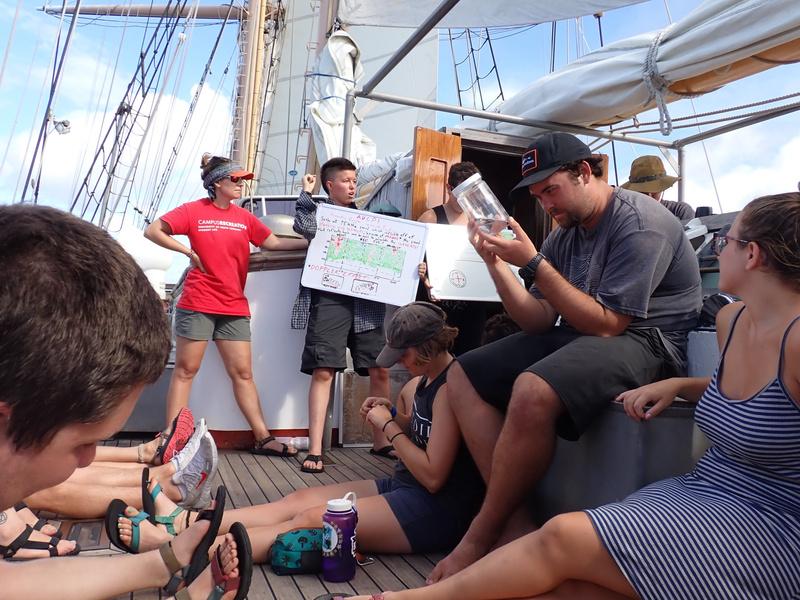
Finally, on variable levels of difficulty and involvement for the ages of our students, inquiry-based, problem-based learning can be central to sparking interest, motivating learning, and creating a productive and educational classroom. Though we can’t ask our students to solve climate change in our classrooms, we can present them with smaller scale problems to address, and ask them to explore and develop their own interests, all the while empowering them as learners and climate activists.
As curriculum that transcends all age levels, we should be encouraging students to explore the outdoors and coexist with nature. We can be creating space either within the school day or permitting (to the best of our abilities) free time away from homework, where students can pursue outdoor endeavors like sports or otherwise to spend time in nature. Furthermore, occasional “outdoor” assignments such as spending time outside, making
by Autumn Crow
So, where is the sea in all of this? Engaging with nature can bring place-based education front and center. When students are learning about the world directly around them, they can connect in a meaningful way and grasp concepts on a level of significance to them. Sea level rise is a symptom of climate change and one that can help us grapple with the stark reality of imminent catastrophe. However, for those who are hundreds of miles away from the ocean and areas widely affected, place-based education cannot illuminate climate change
As a land-locked American from Colorado, sea level rise personally is
cont'd >
In this afternoon class aboard the Seamans, Chief scientist Blaire Umhau (red T-shirt) looks on as student Julius presents on measuring current, while Noah looks at a recently collected biological sample
not a significant concern. I find myself at sea from a passion for sailing and nature, and though I will not face immediate consequences of sea level rise due to climate change, I will certainly feel other symptoms of climate change. Even on the ocean, as mentioned, it, too, is difficult to picture sea level rise with the ocean constantly shifting around me However, on the Pacific, no moment is more real to sea level rise than spending 2,000 miles sailing with only the vast blue and then seeing the sliver of an island such as Howland on the horizon When you realize there is land in this watery world, the whole ocean shifts With that shift, however, it’s blatantly obvious how seemingly vulnerable a tiny strip of land is in the vast expanse of ocean. Not everyone can experience this In fact, few will sail the remote areas of the Pacific and feel the change when land appears on the horizon.
In June, when this SEA class met with the former president of Kiribati and current UN Ambassador Tito, it humanized the consequences of climate change. Getting to shake the hand of a man whose home is thousands of miles away and increasingly threatened by the sea was illuminating. In 2012, current President Anote Tong of Kiribati purchased 6,000 acres of land in Fiji for potential migration of his people
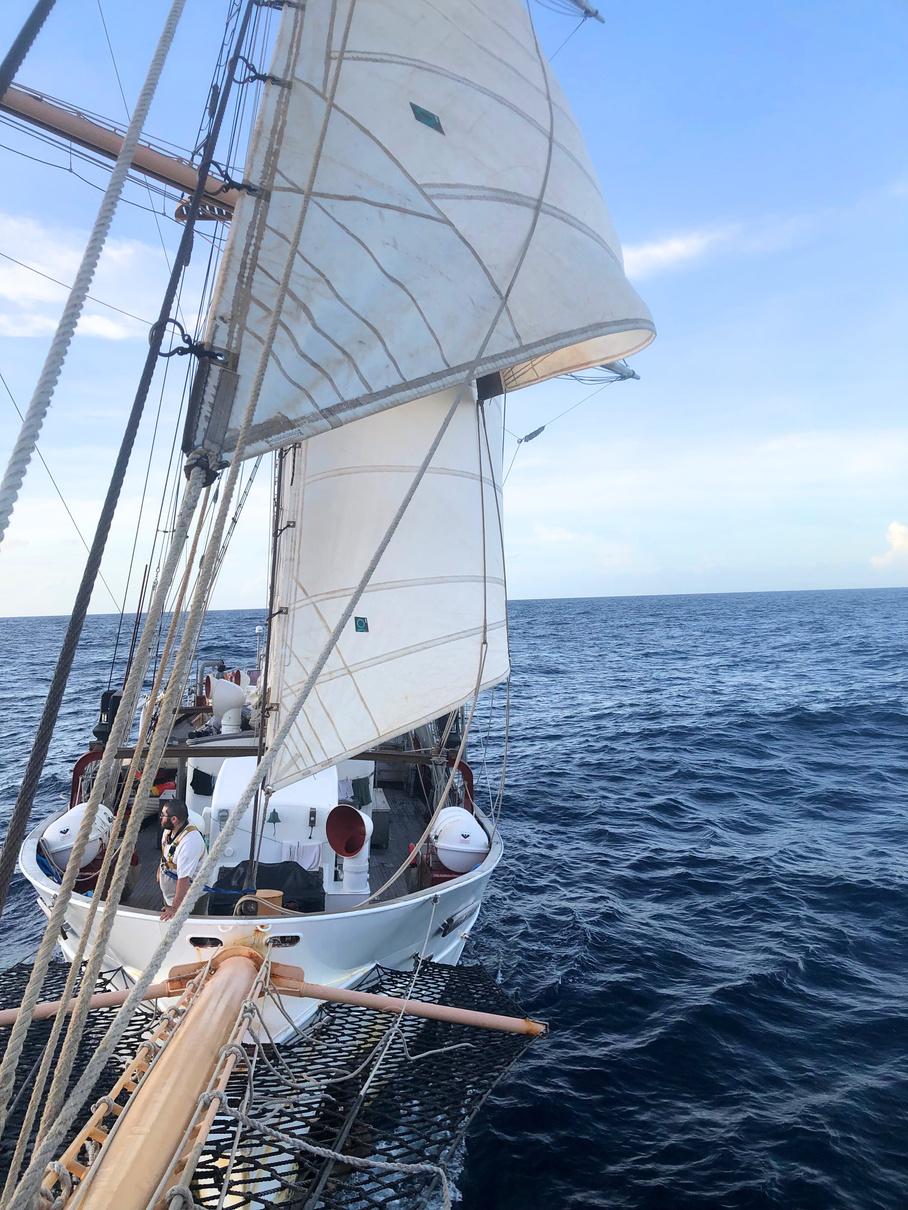 by Autumn Crow
by Autumn Crow
in the future. A Kiribati emigrant, Ioane Teitiota was denied asylum in New Zealand under the claim of unlivable conditions in Kiribati due to climate change These are very real examples of the imminent effects of sea level rise due to climate change on a unique group of people. Though we all cannot fathom sea level rise on the level it will impact these island nations such as Kiribati, the Marshall Islands, Tuvalu and more, possibly within the decade, climate change is impacting all of us every day in all our
cont'd >
While at sea, how do we conceptualize sea level rise and think about its impact on people ashore?
surroundings. States are alighting in flame; species are disappearing; storms and drastic temperature changes afflict our nation. But, at the same time, communities are coming together to defend and create wild spaces, students are learning and exploring climate change inside and outside of the classroom, and research continues to create the best future for our world. If, in exploring the world around us, we can find these other symptoms of climate change, near or far from the ocean, and illuminate them for our students, we can provide them the image and knowledge they need to recognize and fight against climate change. Climate change will be overcome with a sense of place, a sense of love, and a sense of belonging. It begins with our youth. It begins in the hands of our teachers.
by Autumn Crow
Further Reading
Education

Anya Kamenetz, “8 Ways To Teach Climate Change In Almost Any Classroom” (NPR, 2019): https://www npr org/2019
Anya Kamenetz, “Most Teachers Don’t Teach Climate Change; 4 In 5 Parents Wish They Did” (NPR, 2019): https://www.npr.org/2019.
Lora Shin, “Your Guide to Talking With Kids of All Ages About Climate Change” (NRDC, 2019): https://www.nrdc.org/stories/your-guidetalking-kids-all-ages-about-climate-change
Sea Level Rise
Christina Gerhardt, Sea Change: An Atlas of Islands in a Rising Ocean (Berkeley: University of California Press, 2023)
Optimism and Pessimism
Rob Law, “I Have Felt Hopelessness over Climate Change Here Is How We Move Past the Immense Grief,” The Guardian (2019): https://www.theguardian.com...
Catherine Clifford, “The Case for 'Hope Punk' When Talking about Climate Change: 'To Be Hopeless Is To Be Uninformed’” (CNBC, 2021): https://www.cnbc.com...
David Skorton, “The Argument for Environmental Optimism: Opinion by Smithsonian Secretary David J. Skorton” (Smithsonian Insider, 2017): https://insider si edu
Zachary King, “Unconventional Optimism: Lessons from Climate Change Scholars and Activists” (Resilience org, 2020): https://www resilience org/stories
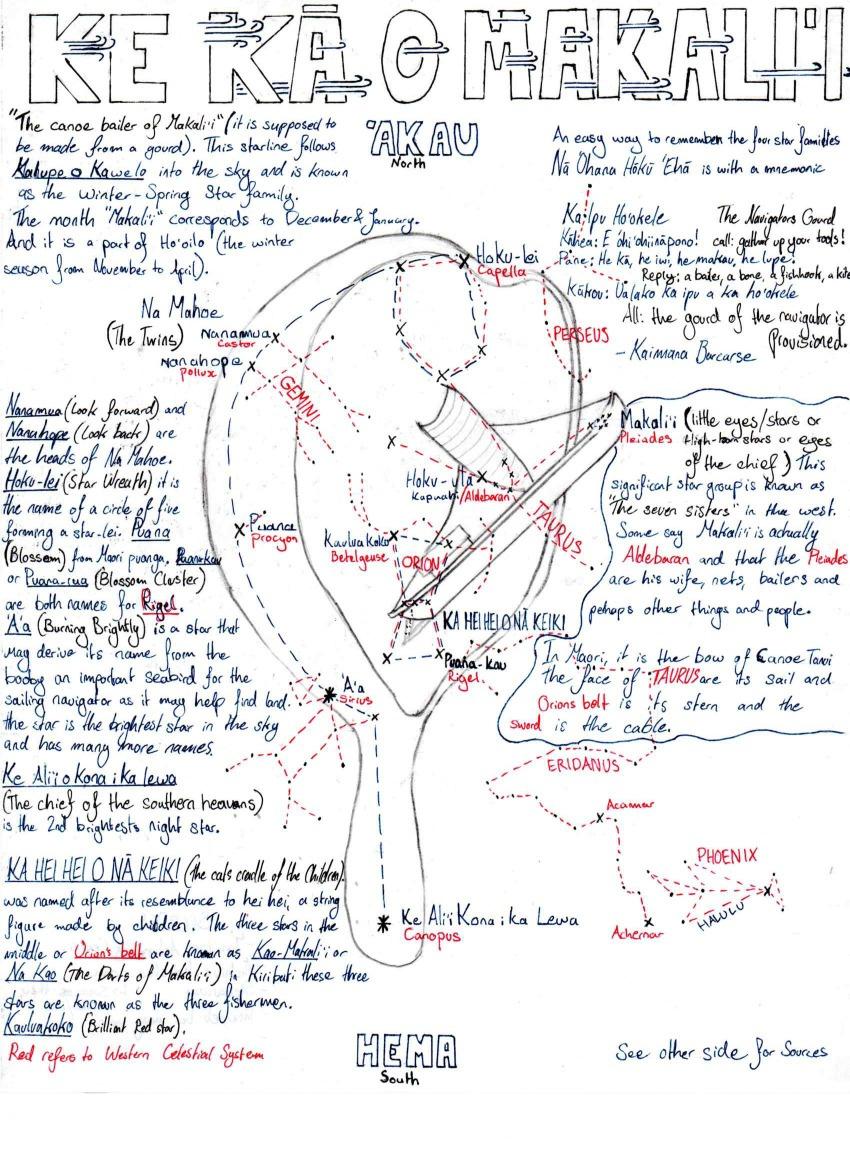
Who Holds the Steer?
Iam Sil, a young human making passage with all my fellow coassociates aboard the Robert C Seamans. I sailed as a student on C’302 where I often found myself peering into the bright night sky on lookout and frequently steering more than 20° off course trying to identify the constellations, their place relative to one and other and to me.
I studied the Western celestial system (which has many stories and myths from Ancient Greece that were preserved by Arab scholars) intensely on my student trip. I was deeply invested in the stories of Orion and Scorpio, Andromeda and her savior Perseus and many more. Yet the Pacific Ocean is a long way away in spacetime from Ancient Greece and the Arab scholars; and it was also a long way for those “first” explorers like Cook, Tasman, Magellan and many other men looking for a legacy, power, and domination
The waters we sail on are sacred, guided by the wind, the current, the
by Sil Kiewiet de Jonge
clouds, the birds, and the stars. Pacific Islanders navigated this ocean long before the conquest of the Europeans. The names of Na’Ohana Hoku ‘Eha, the four star families/starlines from Hawai’i are the Ke Ka o Makali’i (“The Canoe Bailer of Makali’i”), Iwikuamo’o (“The Backbone”), Manaiakalani (“The Chief’s Fishline”), and Ka Lupe o Kawelo (“The Kite of Kawelo/the Chief”)
When the sun set on our first day after leaving Hawai’i the entirety of the Iwikuamo’o connected Hokupa’a (Polaris/North Star) through Na Hiku (Ursa Major/Big Dipper) to Hokule’a (Arcturus in Boötes). Hokule’a is Hawai’i’s zenith star, which means it rises directly above Hawai’i. Although light years away, the warm red glow can be felt on Earth and at sea, thus it is known as “the star of gladness.” If we follow Na Hiku through Hokule’a in an arc we get to Hikianalia (Spica in Virgo) and then we get to Me’e (Corvus) from there we can go straight down to Hanaiakamalama (Crux/Southern Cross), so the backbone is complete covering north to south above us in the night sky. Hokupa’a (Polaris) is
cont'd >
ISSUE 2, 2023
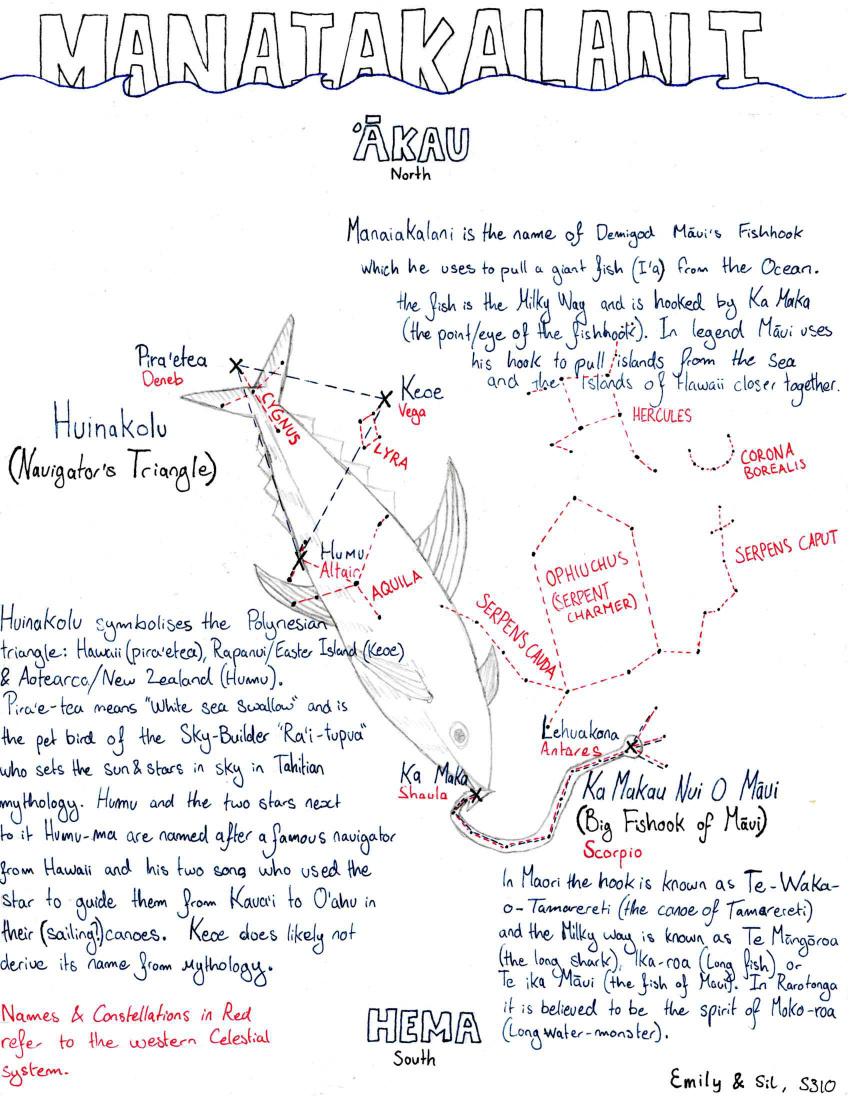
almost exactly the zenith star of 90° North (directly above the North Pole) making it seem “fixed” (the meaning of Hokupa’a in Olelo Hawai’i). When the star disappears below the horizon, one knows that they have passed the equator and are in the Southern Hemisphere
The other stars are definitely not fixed in the night sky though! A couple hours into evening watch and the star line Manaiakalani displaces Iwikuamo’o above us, which is now setting in the west. This star line consists of Huinakolu (“The Navigator’s Triangle”), which consists of the stars Pira’etea (Deneb in Cygnus), Keoe (Vega in Lira) and Humu (Altair in Aquila) and Ka Makau Nui O Maui (“Maui’s Big Fishhook”) known as the constellation of Scorpio. It is nothing short of magical to see Maui’s hook; pulling the “big fish” (the Milky Way) all the way through Pira’etea across the night sky (in other Pacific Island cultures this is same; they speak of a long shark in Aotearoa New Zealand and of a long sea-monster in Rarotonga; some other sources say that Maui isn’t hooking the Milky Way but Pimoe a magical Giant
by Sil Kiewiet de Jonge
Trevally which would be Sagittarius in the West) In mythology Maui uses his powerful hook to lift lands from the sea and bring the islands of Hawai’i closer together. When the watch switches from evening to dawn at 0100 we see the third star line appear, Ka Lupe o Kawelo (Kawelo’s Great Kite), which consists of connecting the western constellation of Pegasus to the sea monster (Cetus) and the southern fish (Pisces Austrinus), south all the way to Iwa Keli’i (The Frigate Bird, Cassiopea in the West) which will point north Ke Ka o Makali’i (“the Canoe Bailer of Makali’i”) cannot be seen this time of the year as it is hiding behind our big lovely day-star (the Sun).
I understand me explaining this to you, feebly attempting to communicate what these star lines look like and mean, from one side of the world to another, may not be of much use to your spacetime.
However, they have provided me with a profound sense of place both physically in the universe and the world, but also to our mutual mother earth and my life in this spacetime. These star lines are a miracle in one more way: they come from peoples who have been subject to colonization and imperialism My ability to learn them is a direct result of their fight to keep their culture and heritage alive in the face of colonization and all the horror that

cont'd >
Hokule’a is Hawai’i’s zenith star, which means it rises directly above Hawai’i.

has come with it and the wake of terror it has left behind It goes without saying that learning these star lines is a privilege and that there is something about them that I (a kid from the other side of the world) may perhaps never truly understand or be able to connect to, but to me, that is what makes them so much more special.
by Sil Kiewiet de Jonge
Further Reading
Bishop Museum. “Sky Maps.”
https://www.bishopmuseum.org/skymaps.
‘Imiloa “September 2023 Sky Watch ”

https://imiloahawaii.org/sky-charts.
Polynesian Voyaging Society “Hawaiian Star Lines and Names for Stars ”
https://archive hokulea com
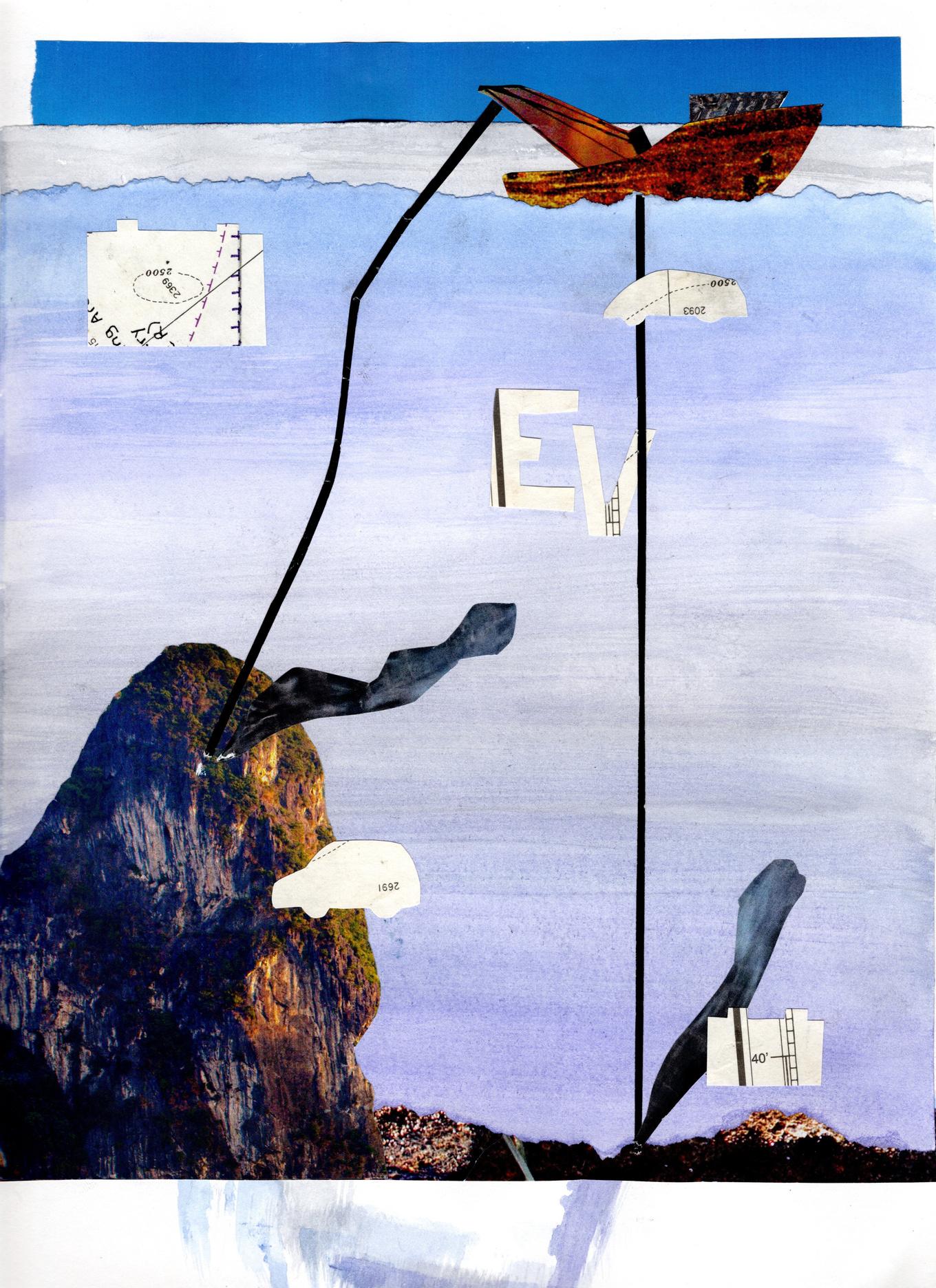
The Forgotten Realm’s Dilemma
t the bottom of the sea lives a potato. Well… a ferromanganese nodule, composed of some of the earth’s most valuable metals, which has taken millions of years to form into the appearance of a potato. Suddenly in the black depths of the sea, a blinding and deafening machine comes along and scrapes the potato from its residence for the past millennia. The potato is plucked out of the dirt and muck and brought up to the dry side to be melted down and twisted into a battery to live in your car or your phone. The glorious natural processes of the last era are erased and thrown into a landfill within a year or two
Deep sea mining (DSM) is the extraction of valuable metals from the seabed in the form of nodules, cobalt rich crusts, or massive sulfides. Each of these forms of metal deposit requires intense and expensive extraction methods due to the difficult access of the sea floor.
 by Hallie Rockcress
by Hallie Rockcress
The mining operations send remote operated vehicles to search and gather deep sea deposits between 200 to 6,000 meters below the surface. However, due to the unreachability of these locations it is a widely unexplored resource, despite its discovery over 150 years ago by the HMS Challenger There was a movement in the early 197080s to explore this resource, but in 1982 the United Nations Convention of the Law of the Sea (UNCLOS) established the International Seabed Authority (ISA) to regulate and monitor these processes After that, interest dwindled, and research plateaued due to the complexity of
cont'd
>
A
ISSUE 2, 2023
A deep-sea mining vessel, the Maersk Launcher, from The Metals Company in the Pacific Ocean The craft can begin commercial operations for exploiting deep-sea deposits as soon as 2024
the operation. And due to the lack of interest in commercializing the resource, there is limited research completed about the ecosystems that exist and what harm might occur from DSM.

From the limited research completed, however, there is one thing to be true: the ocean floor moves slowly The animals move leisurely, if at all, to find food or a mate. The nodules take more than millions of years to form. So when dramatic change occurs, it is essentially impossible for the system to return to a stable state. A study in 2018 analyzed the remnants of a mining site from 1978. The researchers found perfectly preserved tire tracks left from the machinery that had a millimeter of dust and the only change is the absence of all life. Even then scientists aren’t sure about where or what the life of the seafloor is. Many theorize that jellyfish, sponges, and other creatures use the deposits as habitation and have found decreased levels in reproduction where the deposits have been removed.
The region below 200 meters water holds 95% of the world’s ocean and is the biggest habitat on the planet. There are more places to be concerned than just the bottom, such as the midwater ecosystems A study completed in 2020, looked at the potential effects of the mining machines along midwater
by Hallie Rockcress
ecosystems. Concerns arose from the ROVs that sort the deposits from the surrounding dirt sending plumes of ultrafine sediment into the entire water column. The dust particles have caused respiratory problems for many organisms and caused temporary blindness from the cloudiness combined with the extremely bright lights of the machinery. Many marine mammals have been documented to struggle with hunting or finding mates. Many of the studies done to date evaluated the potential effects of mining operations, since there are no exploitation permits allowed until later this year.
This past spring the Biden-Harris Administration announced its goal to transition fifty percent of new vehicle sales to be electric by 2030 This comes as part of the Investing in America Agenda, which funds private and public sectors to invest in EV development. Despite its good intent, this goal puts pressure on the depleted terrestrial metals industry, so companies are looking to DSM for a quick fix solution rather than
cont'd >
From the limited research completed, there is one thing to be true: the ocean floor moves slowly.
“Mining-generated sediment plumes and noise have a variety of possible effects on pelagic taxa Organisms and plume impacts are not to scale ” (Amanda Dillon, graphic artist; from Drazen,
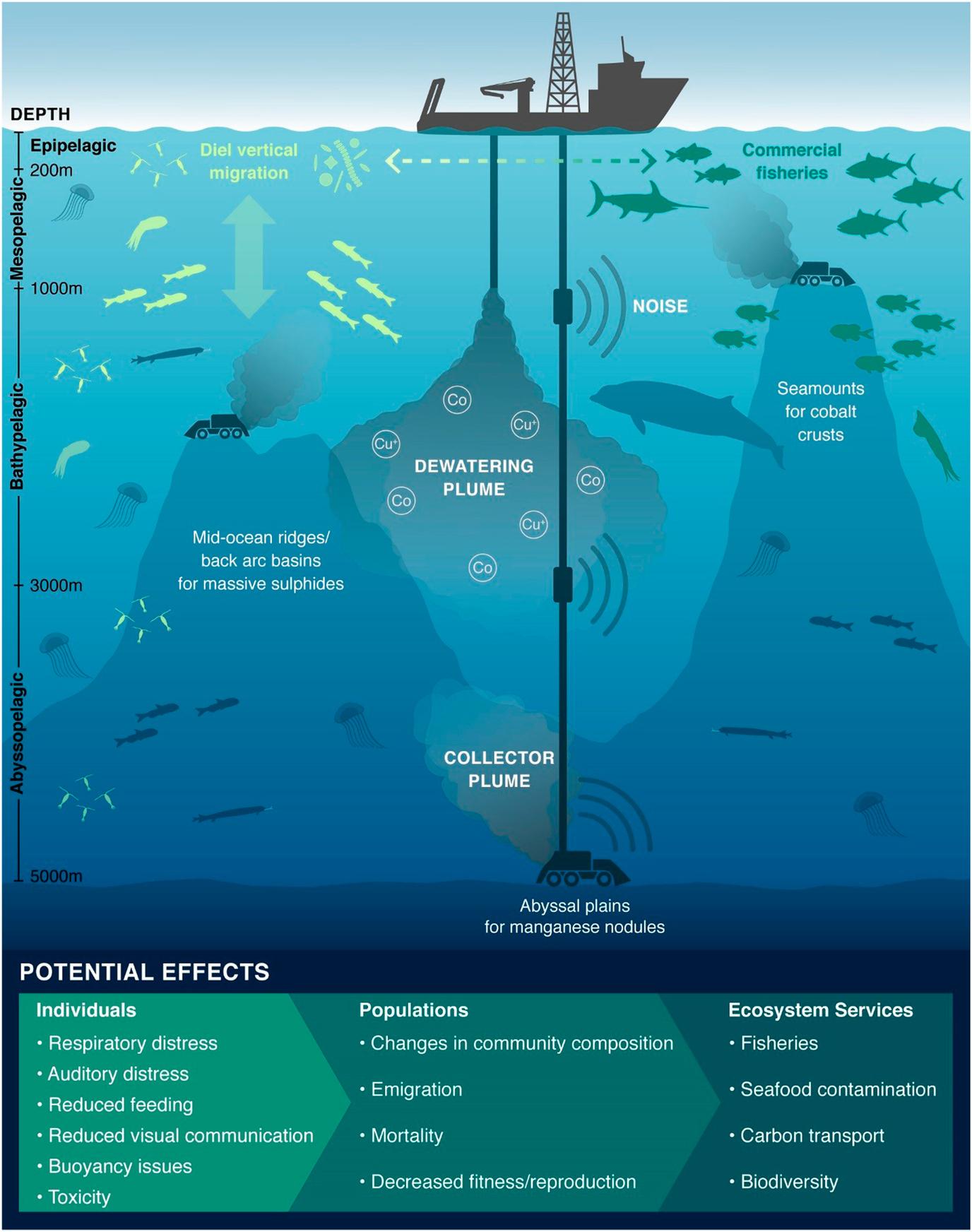
et al )
evaluating the state of the circular economy The ISA include 167 member states and the United States currently has not ratified the UNCLOS, despite the current administration's goal to strengthen "secure access to critical mineral supply chains."
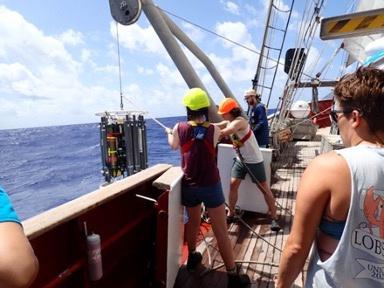
These announcements come at a delicate time due to the ISA’s time limit on Mining Codes running out. The Mining Code refers to the regulations under which companies and their sponsor country can apply for exploitation permits and provides guidance on well-managed mining activities. In the summer of 2023, the ISA legally must start accepting applications for extraction permits if there were mining regulations or not. Currently, there are none. Prior to July the ISA was only able to allow exploration permits and no environmental regulations set for evaluation. Furthermore, there are many efforts to protect our oceans, like the Ocean Climate Action Plan, but these rulings neglect the rising implications and dangers of extraction projects.
However, a circular economy would be a reboot of the current economic model under capitalism. It is common economic thought to regard the Earth’s resources as infinite and replaceable by human capital, which is without reasonable planetary boundaries. This
by Hallie Rockcress
misinformed advice leaves policy makers ignorant of current climate calamities Rather than looking into the unknown and therefore destroying an ecosystem that is far removed from anthropogenic change, we need to reevaluate what we already have. A European Commission initiative from 2015 adopts the practice for a circular economy of rare metal materials. The initiative focuses on recycling and changing consumer mindset on modern technology. There are current projects that look into landfill mining to extract disposed lithium batteries and grant them a second or third life.
If projects in DSM continue, there needs to be an equal investment from companies and countries into research. There is a need for
cont'd >
Asst. Scientist Carly Cooper (yellow helmet) and student Sam Barresi (orange helmet) help deploy the CTD carousel aboard Seamans
renewable energy, and if DSM is our only way of large-scale obtainment, then there are necessary measures in order to protect our forgotten realms. Research vessels like the Robert C. Seamans can continue to do independent research to create foundations for further analysis on the effects of mining on the water column and organisms in the midwaters.
Although we only sailed a few hundreds miles to the west this past summer, other SEA voyages have sailed over the Clarion-Clipperton Zone (CCZ) The CCZ is the most surveyed region for DSM and currently has seventeen permits for exploration. Many policy experts engage with integrated ocean management, which calls for harnessing knowledge, increase stakeholders’ engagement, and establishing better, more secure private public partnerships. A healthy and resilient ocean is the goal for all, but where should we stand in the destruction of something we don't understand?
Further Reading
Jan-Gunnar Winther, et al., “Integrated Ocean Management for a Sustainable Ocean Economy,” Nature Ecology and Evolution 4 (2020): 1451-58

K.A. Miller, K. F. Thompson, P. Johnston, and D. Santillo “An Overview of Seabed Mining Including the Current State of Development, Environmental Impacts, and Knowledge Gaps,” Frontiers in Marine Science 4, no. 418 (2018): doi 10.3389/fmars.2017.00418
“FACT SHEET: Biden-Harris Administration Announces New Private and Public Sector Investments for Affordable Electric Vehicles,” The White House (April 17, 2023): https://www whitehouse gov
by Hallie Rockcress
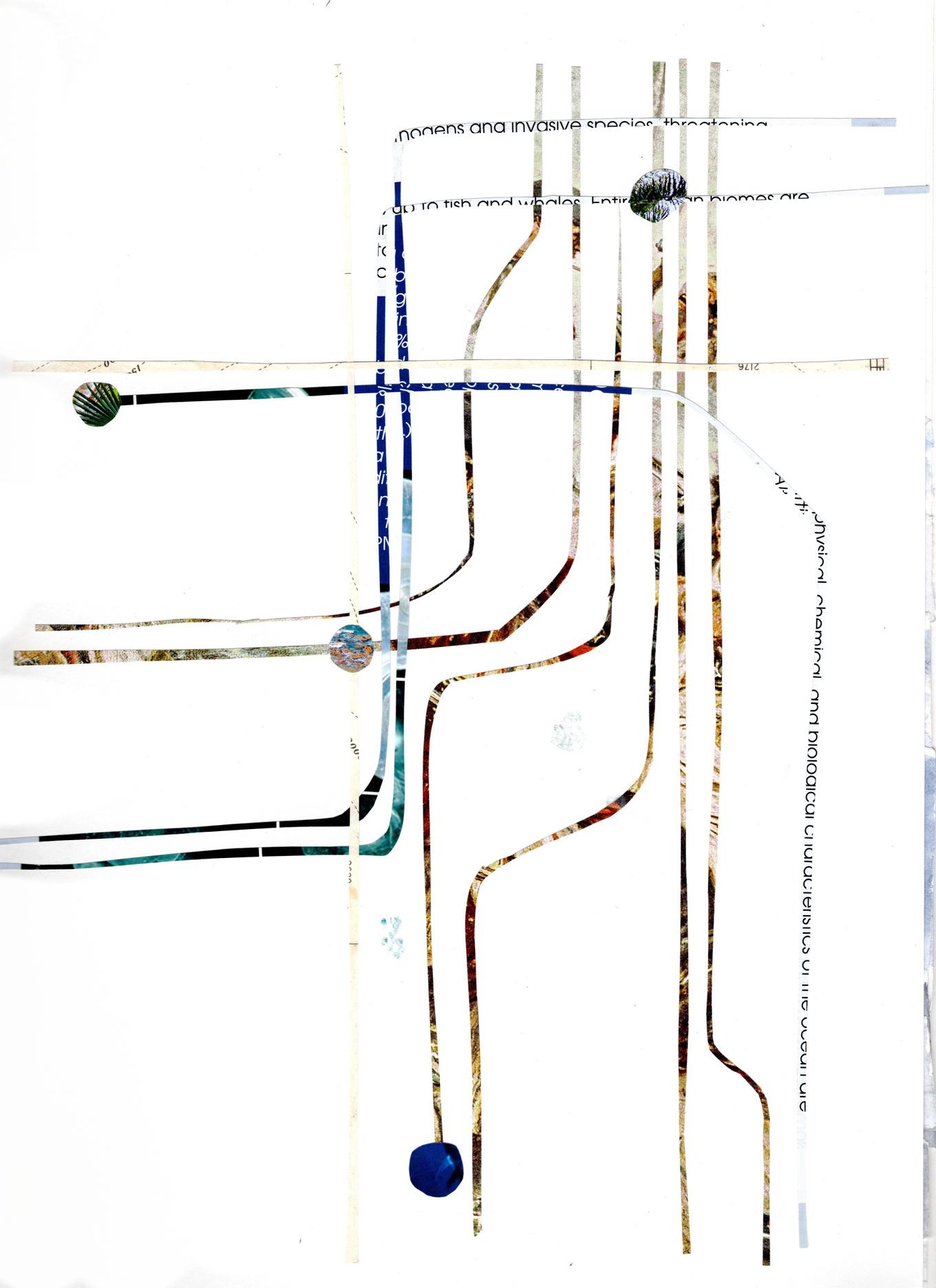
Energizing the Pacific Islands
ormer President of the United States, Barack Obama, said during the 2014 U N Climate Summit, “The nations that contribute the least to climate change often stand to lose the most.” This is the case of the island nations of the Pacific Ocean, whose low-lying islands with little to no elevation are already seeing the effects of global warming in the form of rising sea levels claiming their lands and spoiling their already precious supply of fresh water. The consumption of fossil fuels and their carbon emissions are the largest contributor to rising oceanic and atmospheric temperatures. However, the Pacific Island Nations have contributed next to nothing to this increase. In terms of energy use and infrastructure, the Pacific Islands remain one of the least developed regions in the world While there are high amounts of
by Caleb Fineske
Fvariation as to the amounts of people with access to power, dependent on the island nation, overall, according to the World Data Bank, only twenty percent of homes have electrical power and around only half of the population have access to electricity at all. If the majority of the governments and citizens of the Pacific Island Nations want industrialization, or at least, better access to electricity, why is it taking so long to do so?
Why has electrification not begun?
From my personal research, information has been incredibly hard to come by, which may act as a symptom of the broader issue of the lack of implementation of power systems in the Pacific Islands. PostCovid, the amount of research regarding electrification diminishes significantly. Furthermore, it was remarked by the 2022 U N Review of Maritime Trade that trade routes and distribution of goods to the Pacific Islands has decreased continually since 2006.
cont'd >
ISSUE 2, 2023
Beyond the lack of easy-to-find online reporting on current energy information, the Pacific Island Nations have a unique set of barriers towards development of a broader energy grid and implementation of electricity to the majority of their inhabitants, predominately due to their population and land geography. The Pacific Islands are some of the most remote locations on the planet, with expanses of ocean up to thousands of miles between both each other and the nearest continental landmasses They are further marked by being some of the lowest across the globe in both total population and landmass. Because of their remote nature, lack of industrial infrastructure, and low populations, the inhabitants lack the
by Caleb Fineske
capital to produce technical goods and other items This leads to very high percentages of importation for the goods they lack the infrastructure to produce, as well as one of their largest imports, which is petroleum-based fuels. Despite this high need of imported goods, the majority of the Pacific Island Nations are among the least connected countries in terms of shipping routes, according to the 2022 U.N. Conference on Trade and Development The main points of the economies of the Pacific Islands are much the same amongst them, being dominated by fishing, agriculture, and tourism, all of which take fuel to power them. Many inhabitants of these nations also engage in subsistence-based
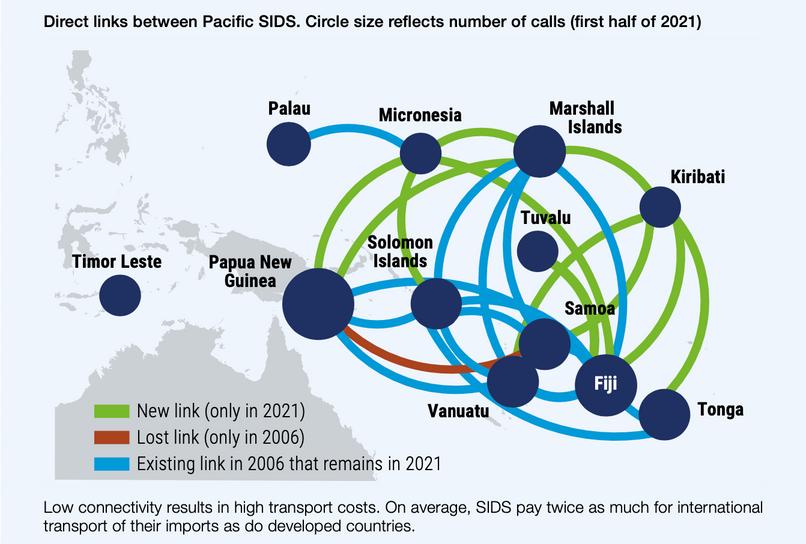
cont'd >
“Liner Shipping Connectivity in Small Island Developing States (SIDS) in the Pacific” UN Review of Maritime Transport (2022)
economies, resulting in the average income per capita of the fourteen Pacific Island nations, such as The Solomon Islands and Kiribati, to be nearly $3,600 USD according to the World Data Bank’s report in 2021. With these low incomes in mind, as well as the lack of a preexisting industrial infrastructure, the governments of these many island countries have had trouble garnering the funds to create nationwide energy grids. The startup costs of importation and setup of these numerous delicate technical components would be quite the financial undertaking in any global location, let alone across the thousands of islands that make up this region.
While some energy infrastructure exists across the many islands and nations, they are usually focused on single islands with the highest populations. Prime examples of this are Nauru and Tuvalu, single island nations with populations of roughly ten thousand each; another is Kiritimati Island in Kiribati. Since they each have a high population density compared to other island nations or other islands within their own nation, efforts to provide energy across them have been quite successful, with all inhabitants having access to electricity. However, as the scope is widened to the many rural areas and less densely inhabited islands in these
by Caleb Fineske

nations, the power grids and access to electricity drastically worsen
Benefits of Renewables
The lack of infrastructure pertaining to energy systems in the Pacific Islands definitely has its silver lining. In a world where developed and developing nations are increasingly reliant on fossil fuel consumption to power their every aspect, the ability to start fresh, unafflicted by reliance on one type of energy source has numerous merits.
grid.
Many nations have the base of their electrical grids firmly rooted in power generated via fossil fuels, resulting in their continued use The process of shifting a grid to include or become based in renewable sources is a long, arduous undertaking. However, under the circumstance that is met by many of the Pacific Island Nations, they have the opportunity to start anew and bypass the adjustment costs of transferring an energy grid. With an initial start with renewable energies, they might reap the most benefits
cont'd
>
Pacific Island Nations...have the opportunity to start anew and bypass the adjustment costs of transferring an energy
available too; the earlier renewables are implemented, the sooner one does not have to pay for fuels, the sooner the renewable energy source begins to pay for itself and cover its costs. This concept is increasingly important in the context of the Pacific Islands, where according to Cole & Banks in 2017, one of the largest national expenditures is fuel imports Through the implementation of renewable energies, importation costs would be reduced significantly, allowing the development of numerous other industrial and social infrastructures such as improvements in hospitals, creation of plants to produce exportable goods, and the ability to create their own technological goods. Implementation of renewable based grids will also give the island nations a sense of energy independence, leaving them less afflicted by the increasing prices of petroleum fuels. Furthermore, due to the widespread nature of the population of the Pacific Island Nations in rural settlements across the many islands of which they are comprised, independent grids of renewables will be much easier to maintain as the only time necessary to interact with them is for general maintenance instead of relying on infrequent resupplies of fuel.
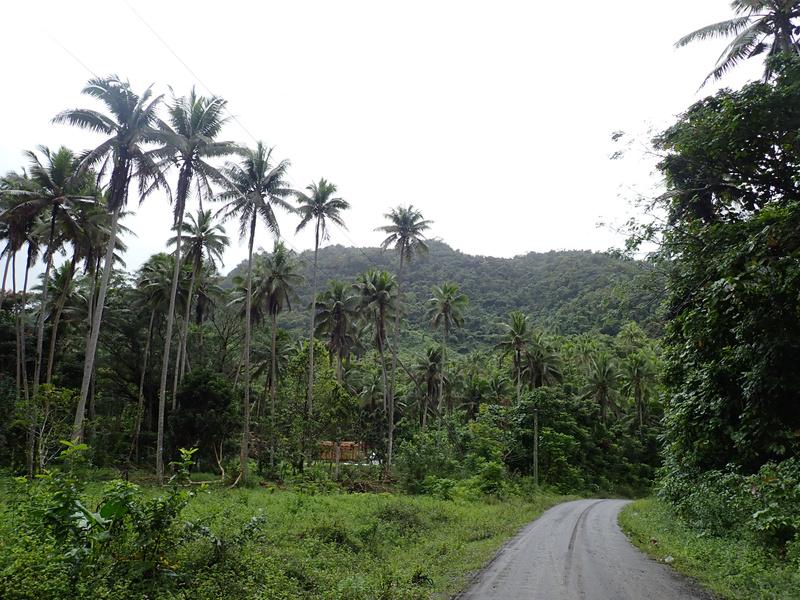
What does the future hold?
The implementation and utilization of renewable energies is a widespread desire across the Pacific Island Nations. For example, by 2020, Niue, Tuvalu, and The Cook Islands aimed to have all their current energy be replaced by that of renewable sources, and numerous others set lofty goals of renewable energy implementation by 2020 as well. Further research must be conducted to determine the extent that these targets were met, however, the intention exists. National governments also have created subsidization plans for rural electrification In Fiji, there exists a plan where the government can pay up to ninety-five percent of the costs of grid expansion. However, this expansion of a renewable power
by Caleb Fineske
cont'd >
A rural view just outside Savusavu, taken from the back of our tourist truck
grid is marked by incredibly high start-up costs To offset these costs, many other nations, predominately the United States, offer money in the form of foreign aid and grants that are dedicated solely to the creation of renewable energy systems amongst the islands, according to Alexander Keeley in 2015
Final Thoughts
The Pacific Island Nations have a unique opportunity to become the first developing region to be powered by renewable energies. Through the implementation and basis of grids in renewable energies, it seemingly provides the answers to give these nations access into global market and make major strides in their own technological development. As said during the United Nations Climate Summit in 2014, renewable energies will “Ensure access to affordable, reliable, sustainable, and modern energy for all."
by Caleb Fineske

Further Reading
M. Dornan, “Access to Electricity in Small Island Developing States of the Pacific: Issues and Challenges,” Renewable and Sustainable Energy Reviews, 31 (2014): 726-735.
A R Keeley, “Renewable Energy in Pacific Small Island Developing States: The role of International Aid and the Enabling Environment from Donor’s Perspectives. Journal of Cleaner Production, 146 (2017): 29–36

Shifting Blue
ime for many of us feels fluid while out at sea, sometimes speeding up and sometimes feeling extremely slow. We end up in our own bubble of watch rotations and meals and our days flow into one another almost seamlessly, each of us following our own schedules within the greater group one, trying to sleep, trying to be present, trying to find time for projects, some relaxing, and spending time with each of the interesting and wonderful people we continue to get closer and closer to. As we change time zones and cross datelines, it’s an extra reminder of time passing, our physical place on the globe, and how things shift and are transient.
A lot of our days follow the same pattern, the things and people we look at are constant enough that slight changes are more noticeable than at a lot of other times in our lives. One of the things I am hyperattuned to while at sea is the constantly changing colors in the
by Hannah Gerrish
sea and the sky – always the same and yet always shifting. Here in the middle of the Pacific on a sunny day the ocean is probably the purest blue I’ve ever encountered. As someone who is accustomed to the green-tinged and often silty glacial waters of the higher latitudes, this bright dark blue caught me off-guard when I first experienced it.
When it’s not too choppy, look down. The sun sends visible beams into the blue, which seems almost iridescent The water is so clear that you can’t really gauge how far down you’re seeing you don’t know what to look at because it’s all just there, deep, and bright, and beautiful. When we do deployments you realize that that indescribable depth to the color is in fact due to the depth of the water; anything that we put below the surface becomes a brilliant shade of turquoise. This turquoise isn’t at all teal-y, nor is it aquamarine. It is genuinely the most pristine blue turquoise I can think of, an unreal color that might look fake if you depicted it in a painting as how it actually appears. Now look up
T
cont'd >
ISSUE 2, 2023
and out. It’s still sunny but your perspective has changed Now you see the surface waves, ripples of movement and color that are never still. We see our first hints of shadowed blue and within it just barely perceptible a ghost of purple. Farther out we reach the dark line of the horizon, also never quite perfect because if you stare hard enough, you’ll see the minute undulations of the persistent ocean swells breaking up even that apparently rigid constant.
Here you meet the sky. At the horizon it’s usually hidden in a low band of clouds, their bases out of reach below your line of sight, their tops billowing into evolving shapes over the light, almost hazy, low sky blue, like a light blue garden flower. Up the gradient you go into darker blue A sky blue, not so different from a clear day at home, just brighter. The sun burns high here, and the light seems to come from all around, reflecting off the sea, off the deckhouses, off each other The sky glows, we glow, and we squint, sometimes even through our sunglasses.
A few hours later the light dampens as the clouds come over to us. They’ve built up and surrounded us with fantastical shapes and then cover the sky. We have a reprieve from the sun’s attack and instantly everything changes. That imperceptible purple in the water
by Hannah Gerrish

now feels more tangible as the deep bright blue begins to feel as though inside it might hold some lavender. The waves become a bit more steely and the chop has an element of grey.
It’s nothing compared to the dark grey curtain that is bearing down on us, however. Down out of the moody navy-grey bottom of a fastapproaching cloud streaks the rain that forms a seemingly solid mass As it comes near, we can see that the line where the curtain meets the water has gone hazy, it has lightened, and then we can hear it coming, whooshing over us and enveloping us in white noise and water The air has cooled and though the rain is warm it’s a wonderful refreshing shock that will last beyond the squall as our clothes stay wet for a moment and give us a reprieve from the hot sun that will soon return. Looking around again as the rain beats down it’s as though we’ve been dropped into a painting. That surface haze softens the edges of everything, the stark saturated colors of tropical sun are reduced to gradients of blues and greys, of
cont'd >
The sky glows, we glow, and we squint, sometimes even through our sunglasses.
slates and steels.
And then it's over Contrast is back and now we can see all those blues at once. The squall is receding with its moody and menacing presence; the myriad kinds and shapes of clouds adorn the sky once more. They are gradients upon gradients, reflecting the warm colors of the sun while retaining their cool blue-grey depths all upon that bright background sky. And the water, again, goes back to being tantalizing. It hints at its depths and invites you in. It sparkles and shimmers and dances with shades and hues and impossible things.
You can notice all these things but describing them is a whole other matter. And what about representing them in art? Trying to paint them? To photograph them? How do you capture something that is never still, something so complex, so transient.
The ocean is often referred to as the ‘big blue’ - both an apt description and drastically undermining the complexity of what we can perceive if we just pay a little bit of attention. Furthermore, at each day’s beginning and end we get a brief new magical palette. We come up from below and out of the lab and our projects We call up our shipmates from the galley and the engine spaces and tumble out of our bunks for sunrise and sunset appreciation time - brief daylight
by Hannah Gerrish
moments when the sun is a joy rather than a struggle. For a while the light turns pure gold Next the sky can be cotton candy or on fire. We revel, both in silence and with giggles and laughter, with smiles on our glowing faces and the wind in our hair, some with arms around each other and some taking advantage of reflective time for self Together, we share these moments, this little bit of the blue world, that keeps moving around us, and with us.

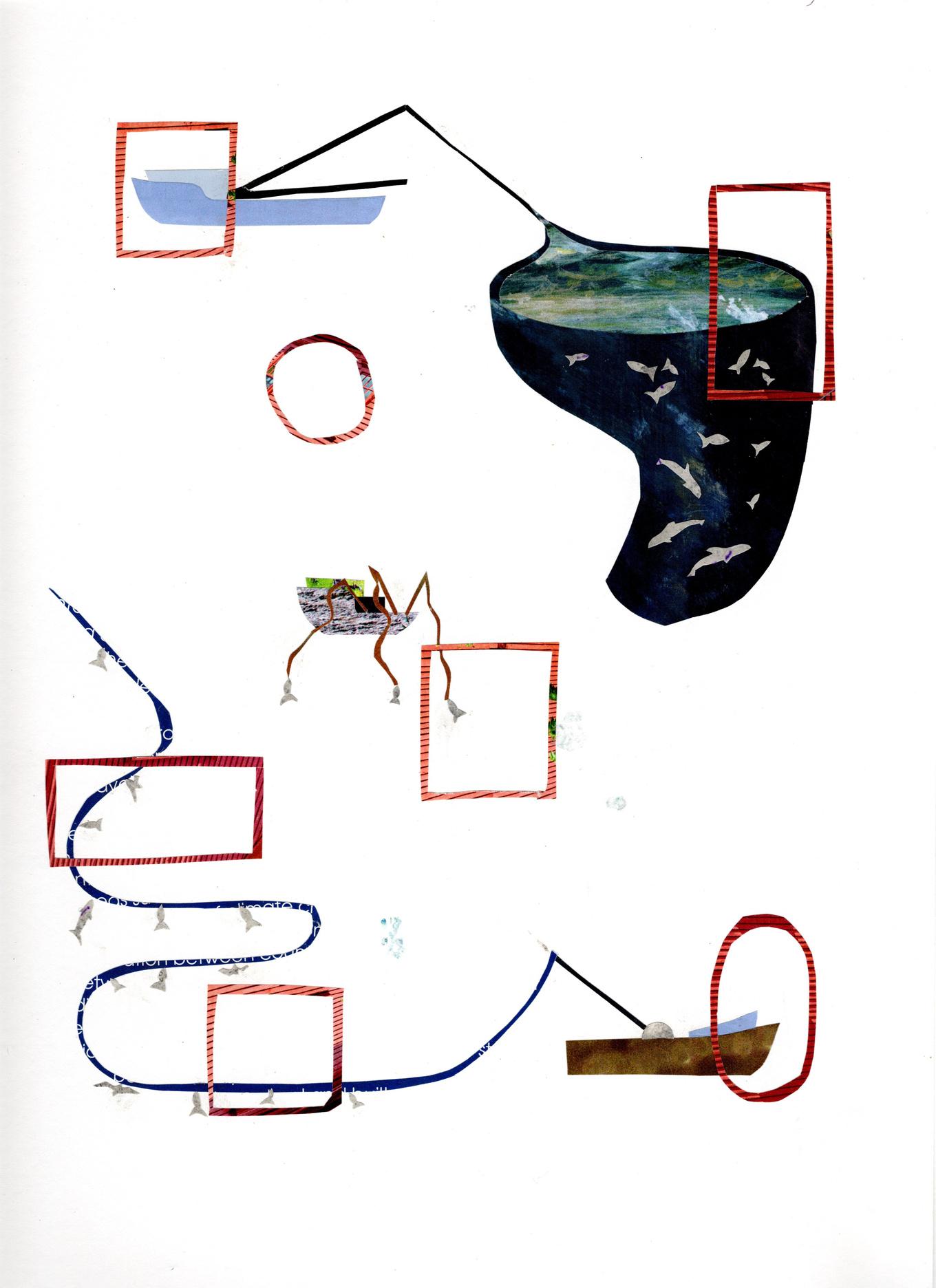
Beyond the Goop: Tuna Larvae and the Pursuit of Sustainable Fishing
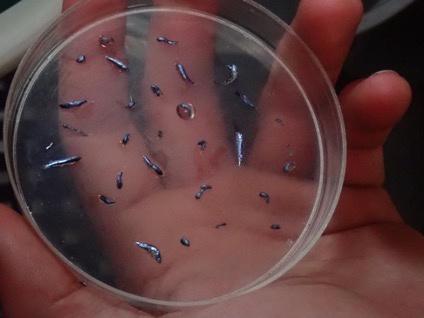
It’s a little after midnight on deck of the Robert C Seamans. The assistant scientists are in the wet lab They stand over a small mesh sieve sifting through a pile of pink and blue planktonic goop, the result of a half hour long zooplankton tow using the neuston net Working meticulously with tweezers they hold up what appears to be a wet gray string no longer than a few millimeters They have found something they have been searching for This wet gray string is a larval fish, one of the first life stages of the albacore tuna
With its ecological, economic, and cultural significance for people, tuna represents an important species in marine ecosystems. Yellowfin tuna (Thunnus albacores), skipjack tuna (Katsuwonus pelamis), and bluefin tuna (Thunnus thynnus) species, among others, occupy predominant positions in the pelagic food chains, exerting top-down control on prey species. As a multi-billion-dollar
by Elijah Busch
industry, tuna fisheries contribute significantly to global food security, international trade, and the livelihoods of millions of people worldwide. However, the sustainability of tuna populations has become a pressing concern due to the combined pressures of overfishing, habitat degradation, and inadequate management practices of some species of tuna. The vast majority of these larval fish will never make it past the larval stage.
cont'd >
ISSUE 2, 2023
A petri dish with larval fish from a neuston net deployment in the American Phoenix Islands near one of the seamounts. The sample is about to be bio-volumed and placed in a small jar of ethanol for later lab research
Amidst the multifaceted discussions about tuna conservation and sustainable fishing practices, my personal connection to the subject takes on a practical dimension. As a committed pescatarian throughout my life, and with both my fathers sharing the same dietary preference, our household places a strong emphasis on minimizing our carbon footprint. We prioritize locallysourced seafood and consciously avoid farmed fish, aligning our choices with the broader mission of responsible consumption. Yet, a notable exception exists in our culinary repertoire – the indulgence in an ahi tuna poké bowl. (Ahi is usually yellowfin or bigeye tuna.) However, this delight prompts a crucial inquiry: How does this prized tuna journey from its aquatic habitat to becoming a delectable centerpiece in a vibrant poké bowl?
Tuna fishing is conducted by various vessels around the world, ranging from small-scale artisanal boats to large industrial fleets The fishing methods employed vary depending on the target species, fishing location, and technological capabilities of the vessels. Understanding these fishing boats and methods is crucial for effective fisheries management and conservation.
Purse seining vessels are commonly used in large scale tuna fishing operations. These vessels deploy a large net called a purse
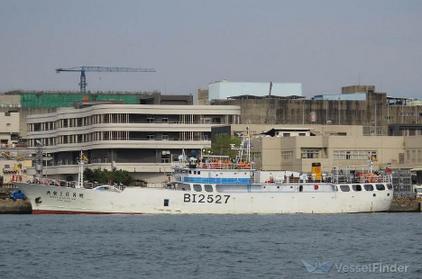 by Elijah Busch
by Elijah Busch
seine around a school of tuna, encircling them. The net is then closed at the bottom to capture the tuna Purse seine fishing is particularly efficient in catching species like skipjack and yellowfin tuna which often swim close to the surface in large schools.
Longline fishing involves setting out a main line that stretches for several kilometers with multiple baited hooks attached at regular intervals. This method targets various tuna species including high value species like bluefin tuna. This method of fishing can be harmful to seabirds who can get tangled up trying to eat the bait from the hooks. It also can be extremely detrimental to other marine life if the long line breaks and entangles other species.
Fish Aggregating Devices (FADs) are floating structures deployed in the ocean to attract tuna and other pelagic species. FAD fishing involves
cont'd >
The longline fishing boat Shan Shun which the Robert C Seamans saw and tried to contact via radio (See image below.)
setting nets or fishing lines around these devices to capture the aggregated fish. While FADs can enhance fishing, they also increase the bycatch of non-target species and contribute to ecosystem impacts.
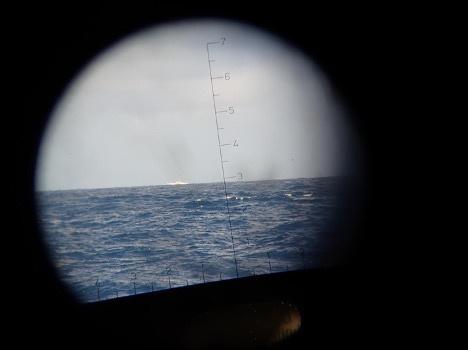
Pole and line fishing is a more sustainable and more selective method for catching tuna. This involves using baited hooks attached to poles, each is individually deployed into the water. This style of fishing is more expensive and takes longer to catch the same number of fish as other techniques, however it
does result in reducing bycatch and minimizing environmental impact
Conservation efforts in the Pacific Ocean have witnessed the establishment of large-scale oceanic marine protected areas (MPAs) in recent years. These MPAs such as the Palau National Marine Sanctuary (PNMS), the Pacific Remote Islands Marine National Monument (PRIMNM), and up until recently the Phoenix Islands Protected Area (PIPA) are designated as no-take reserves to protect marine biodiversity. One of the key justifications for establishing these
by Elijah Busch
cont'd >
The Shang Shun, from Taiwan, a 49m longliner we saw on July 9, 2023 in international waters; their AIS was on, at 4 05’ N x 173 33 8’ W, most likely fishing for tuna or mahi mahi
MPAs is the belief that they will contribute to conserving commercially important tuna stocks in the region. Tuna populations face significant suitability concerns that threaten their long-term viability. According to a 2019 study led by H.R. McDermott, overfishing is a pressing issue with a substantial portion of global tuna stocks being overexploited or fully exploited. If scientists find through this research that there are important areas for fishery stocks, with tuna larvae and other fish, such as spawning locals, that data can be used as a conservation point for creating new MPAs, or at least maintaining current ones.
One of the key justifications for establishing these MPAs in the Central Pacific is the belief that they will contribute to conserving commercially important species (such as tuna) stocks in the region. However, a study by J. Hampton and his colleagues in 2023 raises questions about the efficacy of large scale MPAs for tuna conservation. Hampton conducted a quantitative evaluation of the conservation benefits of the PIPA as well as hypothetical MPAs representing approximately 33% of the western and central Pacific Ocean (WCPO) The study focused on two important tuna species, skipjack and bigeye, which are subject to critical commercial fisheries in the Pacific. The evaluation was based on
by Elijah Busch
a high-resolution modeling framework called SEAPODYM (Spatial et al. Model) and compared control and counterfactual population and fishery dynamics simulations. The study’s findings indicate that PIPA’s conservation benefits for skipjack and bigeye tuna are weak to non-existent, despite the PIPA being located in the core habitat of these tuna species: the MPA's small size relative to their wide distribution and high mobility limits its impact on their population, they found.
The ongoing debate surrounding that study conducted by Hampton et al in 2023 hinges not on the validity of the scientific methodology, but rather on the interpretation of the findings, specifically the significance of the modeled small growth percentages This nuanced aspect has sparked discussions within the scientific community and among tuna experts, who maintain that even marginal growth percentages

cont'd >
One of the key justifications for establishing these MPAs in the Central Pacific is the belief that they will contribute to conserving commercially important species-such as tuna.
hold considerable value for the longterm sustainability of tuna populations
While the interpretation of the study's results continues to be a subject of contention, the consensus among tuna experts is that even incremental improvements in tuna population growth can contribute significantly to the broader goal of conservation. This perspective highlights the inherent value of MPAs as a tool to support the longterm viability of tuna species. As the discourse persists and the scientific community delves deeper into the intricate dynamics of tuna conservation, it becomes evident that the debate surrounding the study's interpretation is a testament to the dedication and passion that drives our collective efforts to ensure a sustainable future for these vital marine creatures
In this journey of scientific inquiry, the interpretation of data becomes a bridge that connects the dots between research findings and real-world implications Ultimately, the ongoing research, combined with the insights from passionate experts, provides a compass for steering the course toward a future where tuna populations thrive, marine ecosystems flourish, and sustainable fishing practices become the cornerstone of responsible ocean stewardship. As these endeavors unfold, it is the collective
by Elijah Busch
effort of those involved that holds the potential to shape a brighter and more sustainable future for tuna and the vast marine world they inhabit.
Further Reading
J Hampton, et al , “Limited Conservation Efficacy of Large-scale Marine Protected Areas for Pacific Skipjack and Bigeye Tunas.” Frontiers in Marine Science 9 (2023): doi org/10 3389/fmars 2022 1060943
G. R., McDermott, et al. “The Blue Paradox: Preemptive Overfishing in Marine Reserves.” Proceedings of the National Academy of Sciences, 116, no 12 (2019): 5319-5325

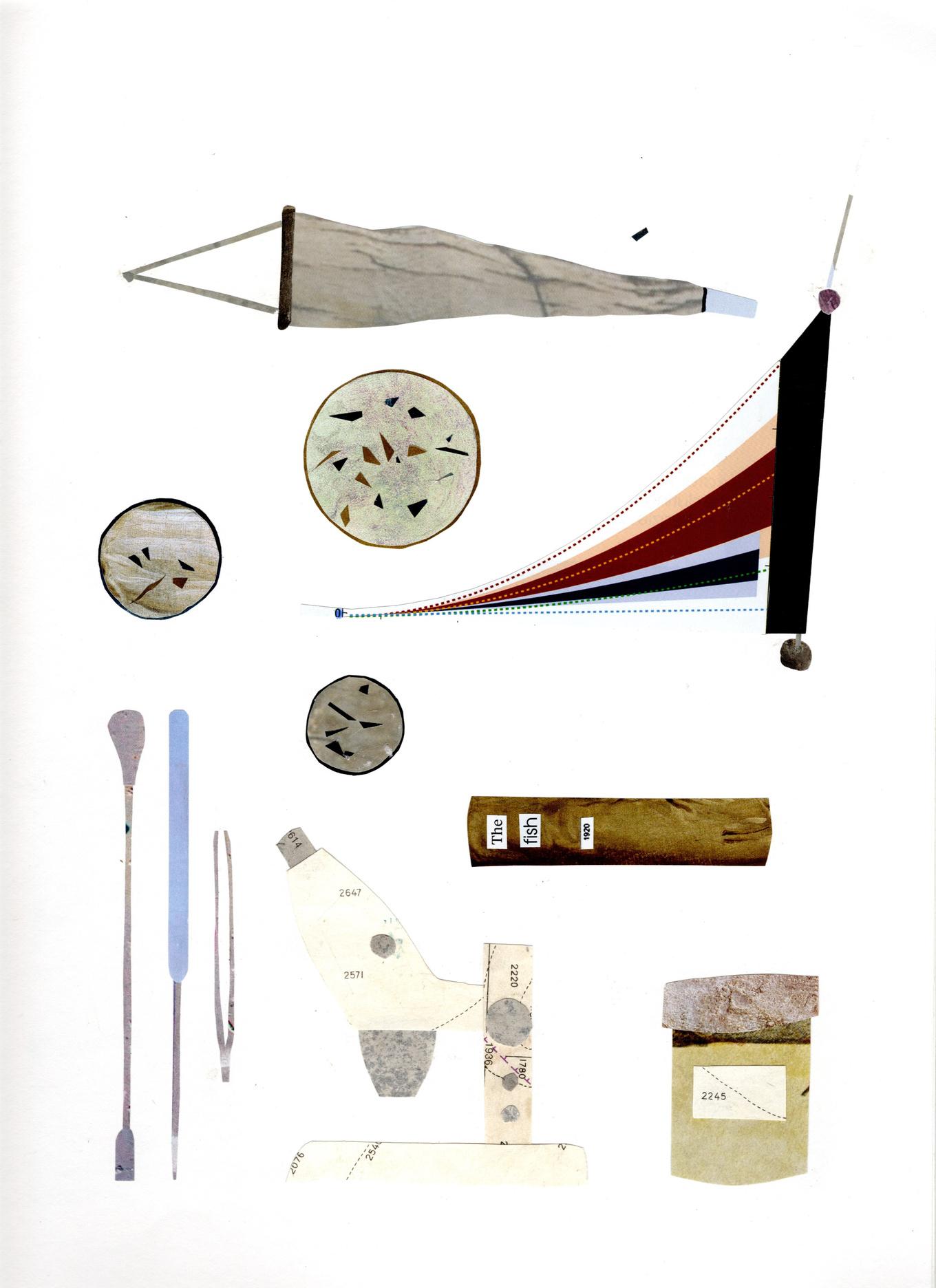
If I Were a Fish, My Dying Wish: You’d Count Me
here is a lot of science that happens aboard the Robert C. Seamans. Students tackle projects relating to navigational tools, phytoplankton diversity, zooplankton diversity, and total alkalinity with the help of assistant scientists and crew members alike. Usually, student projects encompass all of the science along these cruises. Aboard this trip, however, there is another project happening on board We (Allie Cole and Abby Grassick) are visiting scientists from the Rotjan Lab at Boston University and can always be found in the wet lab after nets are deployed, processing biomass and preserving it in jars. We are sorting through what has been fondly named "zoop-goop" (stemming from the fact that it is comprised of lots of zooplankton and gelatinous organisms) for teeny tiny larval fish.
S’310 began in Honolulu, Hawai’i, crossed the Central Pacific, and ended in Nadi, Fiji. Collections
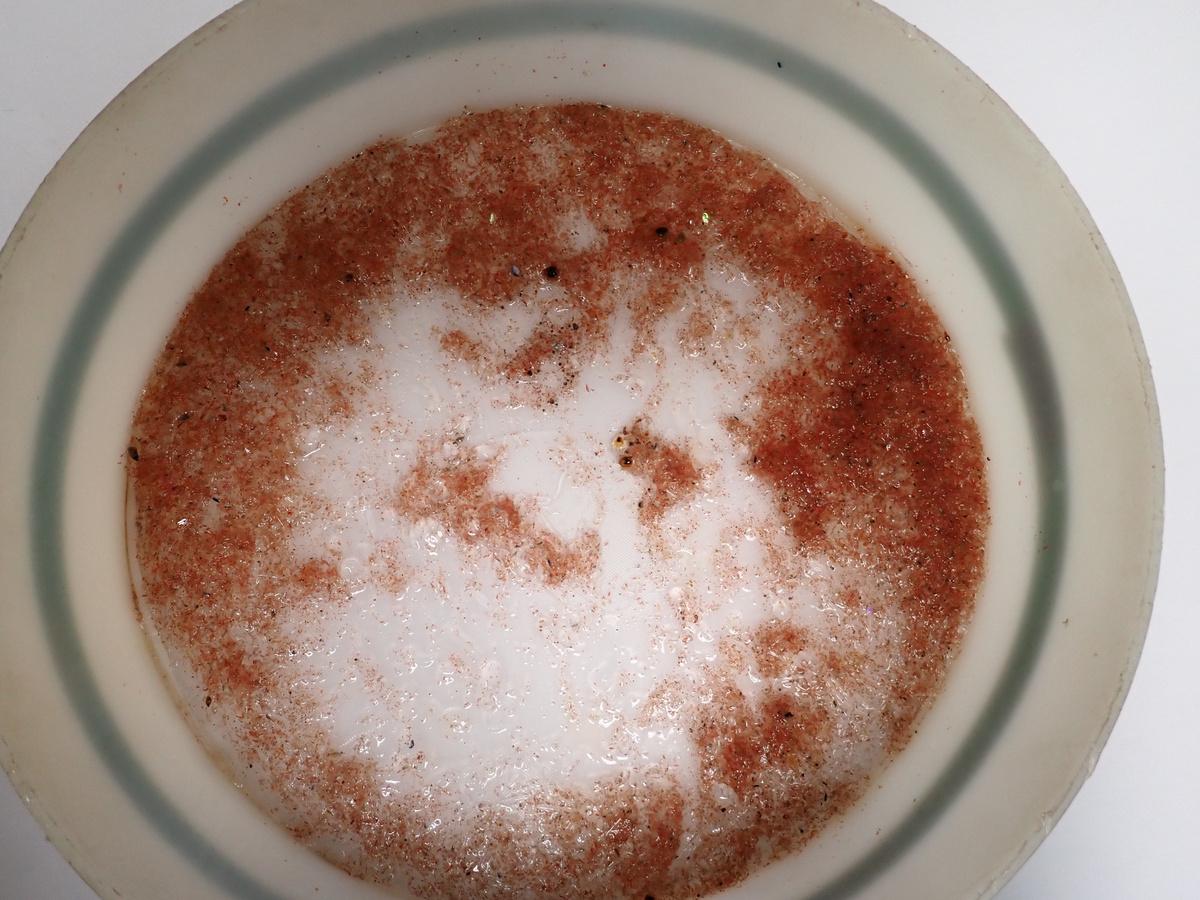
occurred in areas near and within the Pacific Remote Islands Marine National Monument (PRIMNM). This study site is interesting for a few reasons To start, the Central Pacific is a unique ecosystem, home to many large fisheries such as tuna and anchovies. It also serves as a climate laboratory of sorts, as it feels amplified effects of temperature and salinity changes due to ENSO events compared to the rest of the world Furthermore, Marine Protected Areas (MPAs) offer a better perspective into larval ecology, as
by Allie Cole and Abby Grassick
T
cont'd >
ISSUE 2, 2023
Zooplankton “zoop-goop” collected in a neuston tow
there is no fishing occurring within their bounds. This means larval fish, which occupy low levels of the food web, exist in a space with all of their natural predators, unperturbed by human influence.
During larval phases, fish, generally less than one cm in length, are planktonic and cannot swim against the strong currents in the pelagic zone. Due to their small size and inability to swim horizontally for long periods of time, larval fish are vulnerable to predation by other fishes and planktonic organisms alike. They suffer from very low recruitment, meaning that the fate of many larval fish is not to survive into adulthood A combination of low survivorship, small size, and the
general remote nature of study sites in the Pacific, means larval ecology can be very difficult to study. We, along with our lab, are interested in understanding the early life histories of Pacific fishes. Specifically, together we research early schooling behavior and larval assemblages among fishes and other zooplankton. The concept is pretty simple: what kinds of species are found together at this phase in life?
A lot of the science on assemblages is focused towards larger adult fishes, which are easier to capture due to their size. More specifically, this effort is focused on species that are commercially important, such as tuna and anchovies, which are found in
 by Allie Cole and Abby Grassick
by Allie Cole and Abby Grassick
cont'd >
A myctophid caught in a tucker trawl, preserved in ethanol, and presented during class time
abundance in the Central Pacific. There is less information on noncommercial species such as flying fish or half beaks. The lack of available data does not imply a lack of importance; larval and noncommercial species alike all influence the ecology and ecosystem of the broader Pacific Ocean. Larval fish are an important food source for many predators, as well as competitors for resources and vectors for disease. Thus, it is important to understand who they are associating with in order to gain a more holistic understanding of these ecosystems
The world of larval fish is quite small, and much of the ID work can be tedious. Few larval ID guides exist for the Pacific, and many of them primarily cite papers from the 1960s or earlier. Fish must be carefully preserved in ethanol to retain their fragile morphological features. Then,
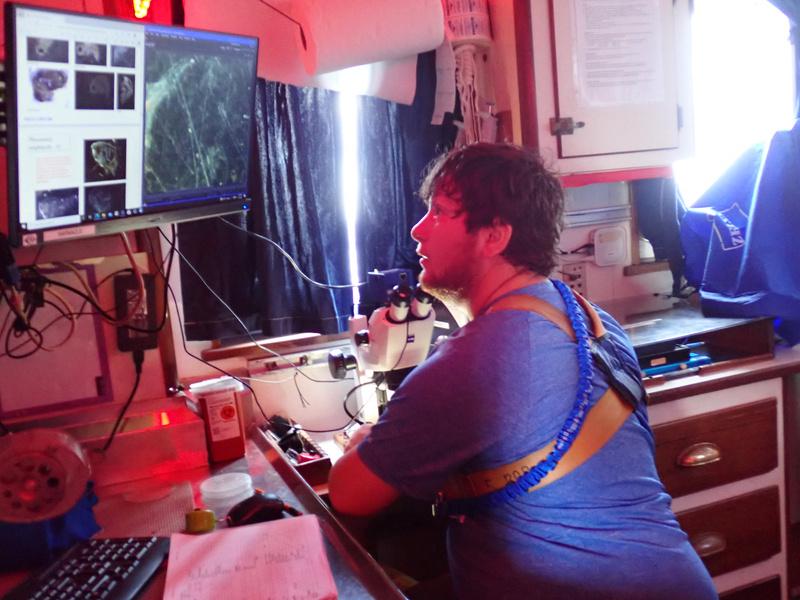
they must be observed through a microscope, and their fin counts, pigmentation patterns, barbles, and body types, etc are used to determine where they fit taxonomically. Some larval fish look quite similar to their adult forms, whereas others can be radically different. All in all, it takes a skilled eye to identify the variety of fish from these samples We have been working on this project for over five years, using almost ten years of data amassed collaboratively between SEA and BU over multiple trips.
In total, there were eighty-eight jars of biomass collected on this trip alone There were forty-seven surface level neuston tows, which skimmed the surface of the water for organisms. The remaining fortyone jars were from shallow and deep tucker tows, which sampled the first 50 and 100 meters of the water column respectively We have already begun working to identify many of the larval fish which we have collected; the larval fishes identified so far come from a vast variety of fish families and will be useful data points in our long term study This trip will help the PRIMNM, a large scale marine protected area, understand their plankton and larval fish communities, which is important information for this MPA and the surrounding waters. This work is supported in part by the Blue Nature Alliance, which is helping to protect cont'd >
by Allie Cole and Abby Grassick
Student Elijah Busch helps to identify plankton species under the microscope in the lab on board
oceans everywhere to improve and protect ocean health
If we can better understand larval ecology we can create a more complete picture of what happens in these remote ecosystems. With this baseline idea of how ecosystems work, with little to no human influence, we can begin to understand how today’s changing climate could affect the world's oceans and the creatures that live in it.

Acknowledgements
This article was written equally by Abby and Allie, who would like to thank SEA Chief Scientists Jan Witting and Blaire Umhau for their collaboration and assistance in the collection of these samples. The title is in reference to “Allie’s Birthday Song,” written and performed by engineer Duane
Stephen Keohane
by Allie Cole and Abby Grassick
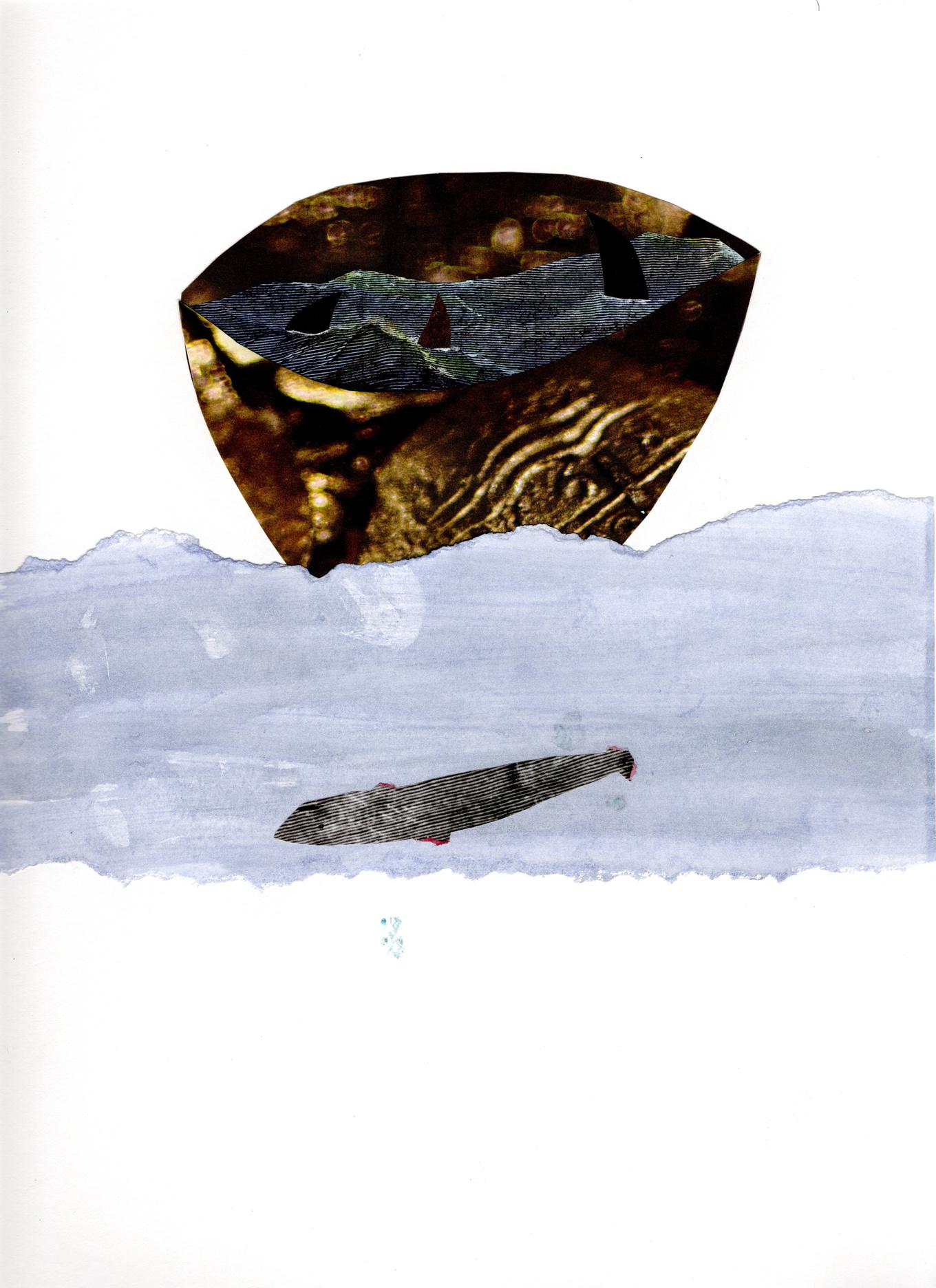
The Shark Unfinned
It is bright and humid on the quarterdeck, and I am meant to be counting seabirds. But luck or instinct has drawn my gaze down, down to the sea and there it is, among the rough planes and angles of the water, appearing as if conjured by my attention. Thin and black, longer than my forearm, moving through the waves with a quiet, steady purpose.
"A fin!" I manage, "Look - lookthere in the water!"
I’m seeking, as I shout, for someone else to confirm that it is real. It’s not as whimsical a desire as it seems in hindsight; the fin doesn’t move entirely like the real things around it The Pacific Ocean, vast and fickle, rocks the ship below my feet; she tugs the seabirds resting on her surface from trough to crest to trough again; but this thing, whatever it is, seems utterly unaffected by the waves. While the rest of us move like a guest in someone else’s home – unfamiliar, accommodating,
by Julius Gabelberger
letting the whims of the water dictate the laws of our motion the shark moves like a king among his courtiers.
And this was how I came to think of it, almost immediately: as a shark. Someone suggested, as we walked back to the lab and the rhythms of the normal day, that it belonged to a dolphin; someone else suggested a mola mola. Maybe, I said, probably. But secretly, whenever I thought of it afterward, that was how I imagined it: a shark, lithe and silent, just below the surface. It was the way the fin moved, most of all, that convinced me. A dolphin or a mola mola might move aimlessly, playfully, drifting or bounding or flopping through the waves. But the movement of that fin through the water was free from waste or uncertainty; it was as inexorable as death.
And perhaps it’s unsurprising that this image is what stuck in my mind. Shark fins are, simply put, iconic They figure in the imagery of horror movies and sports brands, calling to mind in part all the things the shark is as a whole: powerful, unknowable, dangerous. Even the rumor of a
cont'd >
ISSUE 2, 2023
shark fin spotted hundreds of meters from shore will clear out a beach for days And, perhaps most pressingly: shark fins are the centerpiece of a worldwide trade worth hundreds of millions of dollars annually.
Shark fin soup, once a rare delicacy in several countries in Asia (most prominently China), has become more accessible as populations have grown wealthier; at approximately 100 USD per bowl, it serves as a symbol of status and is commonly served at weddings, business dinners, and other events
by Julius Gabelberger
And, as a result of these economic changes, demand has surged over the past several decades, and shark finning operations have grown in response: between 1987 and 2004, world trade shot from 4,900 mt to 13,600 mt (and this includes only reported trade; unreported numbers may be much higher) Shark fins don’t add any flavor; instead, they thicken the soup, the strands of tissue providing an apparently unique texture. But the practice has devastated worldwide shark populations. The shark, captured by
 cont'd >
Painting by Julius Gabelberger
cont'd >
Painting by Julius Gabelberger
the finning operation, is hauled onto the deck like so much meat; its fin is cut from the thrashing body. Then without ceremony or esteem it is thrown back to the sea. The still images of these sharks, stripped of their fins, call to mind ancient statues of Roman gods and goddesses, made limbless by time. But the shark is not a sculpture – it is made not of cold marble, but fragile, bloody flesh, vulnerable to pain and trauma Nor is it yet a corpse; for now, sinking helplessly through the water, it is still a shark.
Specialist Group, tens of millions of sharks die in this way every year.

As in so many other sectors of ocean conservation, one of the major factors is simply a lack of information According to a 20052006 survey from WildAid and the China Wildlife Conservation Association, 80% of interviewees in China “did not know what shark fin (known as ‘fish wing’ in Chinese) is made from.” And while the study notes that average people on the street were not the primary consumers of shark fin soup, the food is becoming more and more available with cheaper dishes.
The shark, finless, cannot swim; and for many species of shark, to be unable to swim is to be unable to breathe. And so the shark comes to rest on the seabed, panicking, airless. If it has not yet died of blood loss - if no hungry predators have found its helpless form - it suffocates there, in the water that has always been its home and shelter. According to the World Conservation Union’s Shark
by Julius Gabelberger
This lack of transparency shadows every level of the industry. According to the Convention on International Trade of Endangered Species (CITES), three-quarters of the global shark fin trade remains unregulated. Furthermore, although CITES lists thirty-eight of the approximately one hundred shark species used in global trade as endangered, because the bodies of finned sharks aren’t kept (and distinguishing between the fins alone is time-consuming and difficult for trade officials) the fins of even these protected shark species are often passed off as those of other, non-protected species, allowing endangered sharks to be further exploited. In the Pacific, silky sharks (Carcharhinus falciformis) and oceanic whitetips (Carcharhinus
cont'd >
Finned shark (Nancy Boucha, Marine PhotoBank/Oceana)
longimanus) are in particular peril, the latter estimated to have declined by up to ninety-five percent in the past three decades - at least in part due to the impacts of shark finning. Quantifying the exact degree to which total shark populations are declining is extraordinarily difficult, in no small part due to the unreliable (and, in many cases, actively deceptive) reporting of shark mortality rates. The industries that interact with sharks are shrouded in layers of obfuscation and misdirection, turbulent depths through which only a fraction of the light penetrates Sharks accidentally caught by commercial fishing operations are often tossed back to the sea without being recorded, where they rarely survive; boats often underreport shark catches, or consider them bycatch and don’t list them at all - as in the case of many Spanish vessels, which, according to one study, in 2021 (ostensibly out catching swordfish), caught more than double the metric tonnage of sharks as that of swordfish. All of these factors – as well as the lack of baseline data for shark populations pre-huntingcontribute a great deal of uncertainty to any estimate of shark mortality rates.
Nevertheless, existing numbers are grim. A 2013 study found that an estimated 100 million sharks are killed every year (with data current at the time of the study); and while shark finning is a particularly
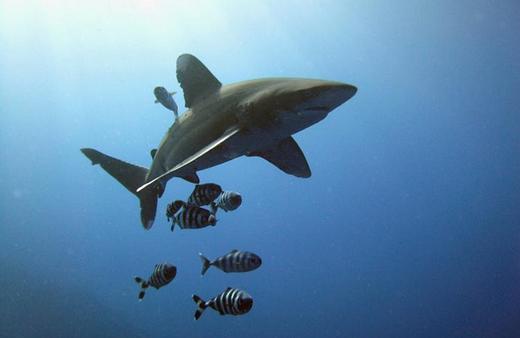 by Julius Gabelberger
by Julius Gabelberger
acute issue, others, such as fishing for other parts (meat, skin, and some parts prized for alleged medical benefits), bycatch with commercially fished species (particularly tuna), and loss of prey species, also play a substantial role in these enormous population declines. Sharks and rays, according to the IUCN (International Union for the Conservation of Nature), have “the lowest percentage of species considered safe –with only 23% categorized as Least Concern.”
But extinction is not yet a foregone conclusion. Sharks are an ancient species, and they have been entwined with humanity as long as we have lived by the water. They figure in religions across the Pacific, as gods and guardian spirits, maneating villains and benevolent forces of protection; serve as keystone species in the thriving reefs that fringe its islands, stabilizing forces for ecosystems pelagic and coastal;
cont'd >
A whitetip shark (NOAA)
and provide tens of millions of dollars to shark-watching and sharkdiving ecotourism organizations every year. So it’s no surprise that conservation efforts have sprung up worldwide in response to the threats facing sharks.
sharks, we see them in part: we see the tail thrashing apart the surf in an online video, or the jaws held suspended in the museum, or - in my case - the fin slicing calmly through unfamiliar waters. But the shark itself – the shark not as victim of bycatch, nor symbol of prestige, nor icon of fear and mystery, but as simply a living being, whole and entire - continues to elude. So, too, what lies ahead for sharks, and for the ocean around them, comes in glimpses and flashes.
Many countries and governing bodies (such as the European Union, Namibia, and Honduras) enforce complete bans on shark finning within their waters or by ships flagged under their nationality, while others (such as Brazil, Costa Rica, and the United States) ban the cutting of the fin from the body, requiring that the shark be kept in its entirety. While these country-bycountry regulations can be somewhat patchy (Japan, for example, has no regulation on shark finning), some international laws do exist around shark conservation In 2022, the Western and Central Pacific Fisheries Commission banned two types of fishing equipment with high rates of shark bycatch (“shark lines” and “wire leaders”), citing the impact on oceanic whitetip and silky sharks
Ultimately, it’s impossible to say what the future holds When we see
 by Julius Gabelberger
by Julius Gabelberger
But this is what we must do, if we want to preserve the animals that have been integral to the Pacific for hundreds of millions of years: piece together the jaws, the meat, the skin, the tail; re-draw the delicate gills; set those impassive eyes into their proper place. Un-fin the shark. So, too, we construct the future: reconcile the predictions, the challenges, the setbacks and successes, and return with one undivided whole.
Further Reading
Philip Jacobson, “Shark-fishing gear banned across much of Pacific in conservation ‘win’ ” Mongabay (Dec 8, 2022): Mongabay com
“World of Sharks,” Save Our Seas Foundation: saveourseas com/worldofsharks
Boris Worm et al., “Global Catches, Exploitation Rates, and Rebuilding Options for Sharks.” Marine Policy, 40 (2013): 194-204

Sharks are an ancient species, and they have been entwined with humanity as long as we have lived by the water.
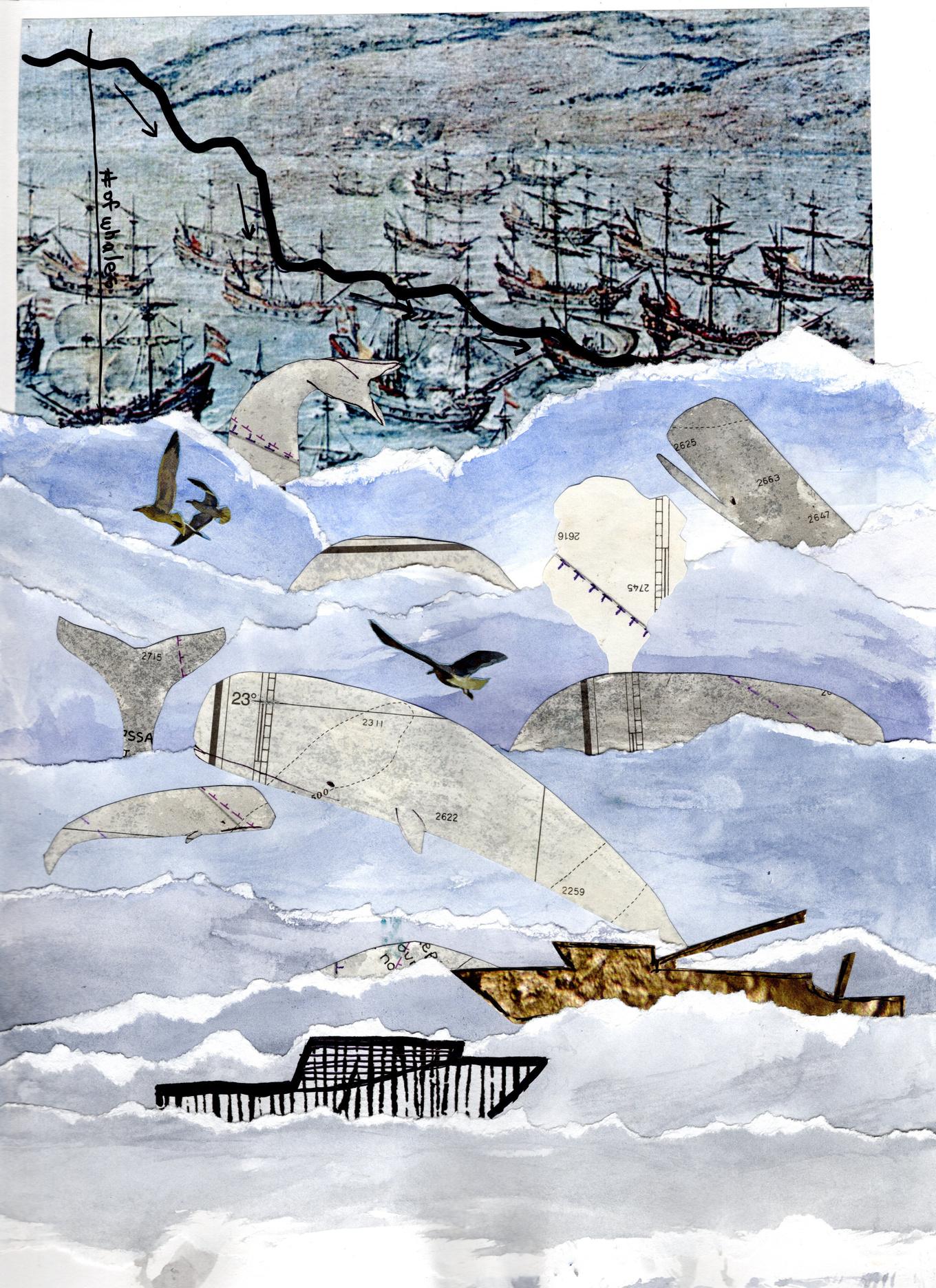
Connecting New England to the Pacific through Sperm Whales
o matter where I go, my New England home follows me. A Boston accent in a Kyoto market, a Red Sox hat in Geneva, shared friends discovered between me and my seat-mate on a slow train to Paris. Now, in the middle of the Pacific, I sit high above the deck of the SSV Robert C. Seamans, scanning the horizon for another sign of home—the spout of a whale New England, particularly places in Massachusetts such as Nantucket, New Bedford, and Falmouth, have a strong history of whaling. The oil that comes from whales caught in the Pacific lit American homes in the 18th and 19th centuries, their baleen used in everything from horsewhips to corsets. The industries surrounding whaling, particularly sperm whales, built New England. The trade, processing, shipping, and candle making brought money and commerce to those coastal towns, building their mansions and ports
 by Abby tenBroek
by Abby tenBroek
and government buildings. Those structures remain in these towns today, even after the overharvesting of whales and a budding reliance on petroleum forced the towns to invest in new industries or sink into disrepair So here I am, sitting in the fighting top, just as the whalers did before me two hundred years ago, both of us searching for a spout or a fluke that will bring us closer to home.
There are two main phases of whaling in the Pacific for commercial purposes: historical whaling, from
cont'd >
N
ISSUE 2, 2023
The view from aloft on the Seamans (Hannah Gerrish)
the middle of the 1700s to around 1910, and modern whaling, which is from around 1910 to the modern day. Historical whaling was hampered by speed: how fast the captain could get the ship to go, how hard the whalers could row to catch up to a whale. Therefore, the whales that could be caught were necessarily slow: right whales, bowheads, and sperm whales. Whales were hunted for their oil: in the days before electricity and kerosene, people were reliant on fireplaces or smokey tallow candles to provide light. Refined whale oil provided a slowburning, low-smoke alternative, and became a sought-after luxury product. Sperm whales are both slow
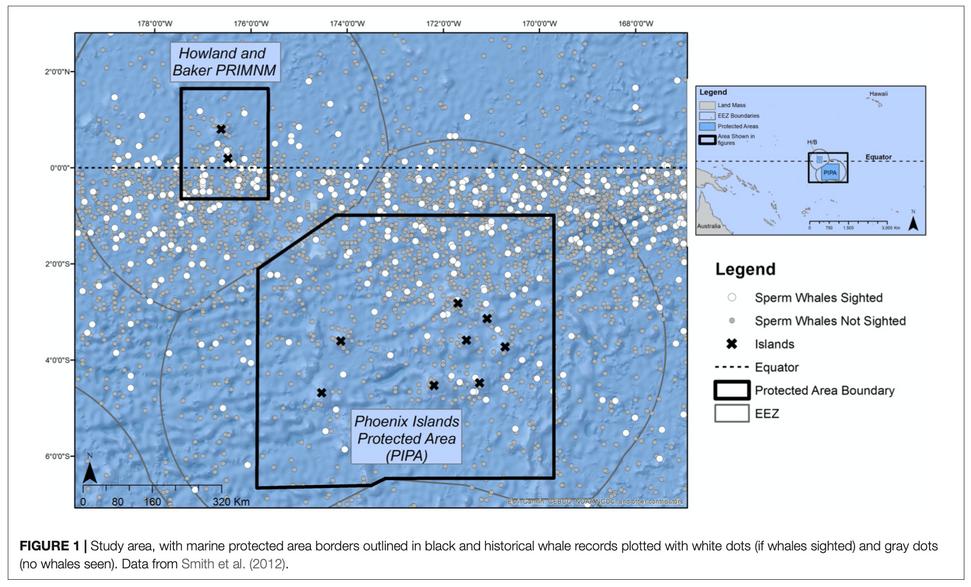
and large, and thus were the ideal target for whalers Large males can provide over a hundred barrels of oil, females twenty to thirty. But after the invention of the steam engine and the explosive harpoon, any whale could be caught, and the whalers stopped discriminating. As whale oil waned in popularity, whales were hunted more for their meat than their oil. Whaling stopped being an American industry, shifting to places where whale meat is popular such as Iceland, Norway, and Japan. Nowadays, even though a much greater variety of whales can be caught, sperm whales are still prized for their large size, taste, and slowness.
by Abby tenBroek
cont'd >
(Published in Kennedy et al , 2020)
Whaling in the Pacific, while farreaching, is seasonal Many whales migrate: they have their calves in warmer southern waters during the winter, and then swim closer to the poles over the summer to feed on the fresh stock of sand eels, krill, and squid. Thus, whalers tend to congregate near the poles to catch the whales coming and going.
Where we are, which is right next to Howland and Baker islands, is a rest stop for whales. Howland and Baker islands are little smudges of sandy beaches that we saw on the 12th and 13th of July Designating Howland and Baker as islands is a bit of a misnomer: they are a part of a chain of seamounts between 0°48.49’
N and 1°41.2’ S, bridging the Exclusive Economic Zones (EEZ) of both Kiribati and the United States. The tops of Howland and Baker are the only two that break the surface, sitting a mere few feet above the waves. These seamounts do something incredible in the otherwise sleepy depths of the Central Pacific. Through their bulk, the seamounts create the island mass effect, which is when the currents, encountering a seamount, are forced down and up again, bringing up the nutrient-dense debris of fecal and other organic matter to the surface. What results is an increase in sea life the whales take advantage of, eating tons and tons of fish every day.
On the 14th of July, I hear a call
by Abby tenBroek
from our chief mate, Rocky His voice rings clear all the way through the ship: “Whale on the port quarter!”
Faster than any fire drill, the ship’s company flows out onto the quarterdeck. We crowd along the rail, on the housetops, onto the boom where the mainsail is furled tight against the frequent equatorial squalls. We wait. Five minutes later, we see a short, bushy spout. Another five minutes later, we see the spout again, and a graceful back, arching for a dive We see three more spouts
over the next half hour, burning and sweating in the afternoon sun. After much debate between our second scientist, Hannah, and our instructor on conservation and management, Rich, we determined that we saw a Bryde’s whale. They are enormous creatures, up to sixty
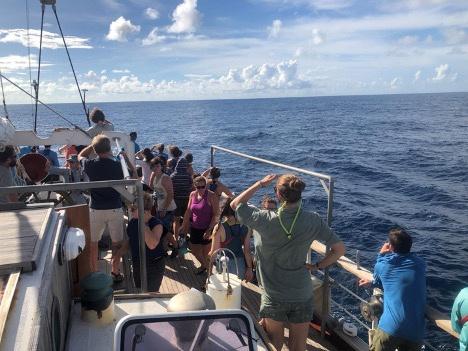
cont'd >
The ship’s company looking out for a whale, July 14, 2023 (Thomas Deveraux)
feet long, using their baleen to filter out big fishes, eating tons of krill a day. Since then, we have seen a handful of whales, including the rare pygmy killer whale and, we’re pretty sure, a small pod of sperm whales. But our sightings pale in comparison to the quantities of whales seen by New England whalers in the age of sail. Even as far back as the 1830s, whalers such as Captain Joy out of New Bedford recognized the human impact on whale populations in the Pacific, how it took longer and longer with each of his subsequent voyages to fill his hold Humankind has been responsible for the devastation of whale populations worldwide one study led by Brian Kennedy in 2020 estimates that between 1820-1870, sperm whale populations were reduced by as much as eighty percent
Despite the harm done by humans, whale conservation is a triumph of environmental legislation. In 1972, the United States passed the Marine Mammal Protection Act (MMPA). This policy forbids the hunting of marine mammals, but also ensures that they are not bothered by humans within US EEZs. Further extensions of the MMPA require that any marine mammal found in distress within a US EEZ be given assistance. United States policy is not global, but the EEZ of the United States is so far reaching that even in some of the most remote parts of the Pacific, whales are protected
by Abby tenBroek
under U.S. federal law.
In 1986, the International Whaling Commission (IWC) passed a moratorium on whaling, but there was an option where member states could opt out of the moratorium, and Japan and a few other nations did just that. Without a means to enforce its own policy, the IWC turned to American lobbying.
Environmentalists in the American Cetacean Society sued the Japanese Whaling Association in 1986, claiming that Japan was in violation
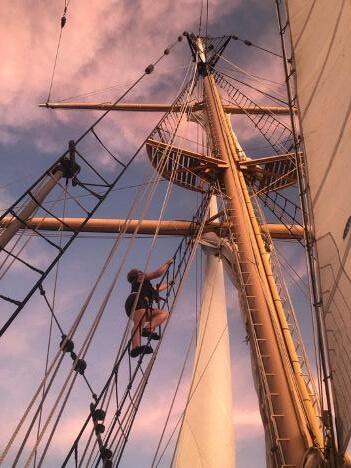
cont'd >
Abby tenBroek (climbing) and Hannah Gerrish (hidden, on the lower top) laying aloft (Thomas Deveraux)
of the treaty. It went to the Supreme Court, and in 1987, the court decided five-to-four in favor of the American Cetacean Society, finding Japan in violation of exceeding a previously established whaling quota. Since


then, Japan, Iceland, and Norway have exited the IWC altogether, and those three countries constitute the vast majority of whaling post-1986. But the moratorium effectively ended the era of indiscriminate whaling Conservation policy has continued through to the modern day, with the United Nations proposing the High Seas Treaty in 2023, although it has yet to be signed by nation states The goal of this treaty is to protect thirty percent of the world's oceans by 2030. These policies show an attitude shift of the public from seeing the sea as an endless resource to something that needs to be protected and respected
Back in the fighting top, I gaze out at the horizon, the squall descending safely behind us. Up to the tops’l yard and back down again to stretch,
by Abby tenBroek
to get a better view. There is no way I could scan all the horizon, no way to possibly see all the places a whale might appear. The novelty of my being aloft playing the part of a whaler is too great for me to care about the pins and needles creeping up my legs, the solitude of being forty feet in the air The sun dips below the horizon and the navigation lights turn on. I am obligated to make my slow, inexperienced way back down to the deck. There were no whales. My sight of home will have to wait, until the next whale, until the next time I go aloft.
Further Reading
R King and the Middlebury College Marine Environmental History Class, “Capt. Joy’s Last Voyage” Earth Island Journal (Summer 2023): 1824
Susan Geha, “International Regulation of Whaling: The United States’ Compromise,” Natural Resources Journal 27 (Fall 1987): 931-40
Brian Kennedy, et al “Historical Trends of Sperm Whale Distribution in the Phoenix Archipelago,” Frontiers in Marine Science 7 (2021): doi org/10 3389/fmars 2020 583326
These policies show an attitude shift of the public from seeing the sea as an endless resource to something that needs to be protected and respected.
Seabirds in the Central Pacific
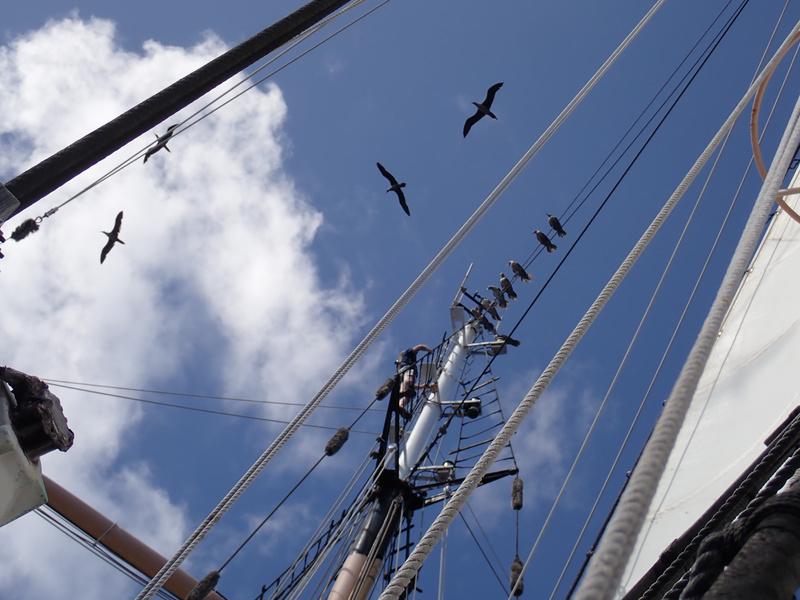
n our first day at sea a red-footed booby perched at the end of the topsail yard. Soon it was joined by a second booby, then a few more, until a few days later the population seemed to peak at around twenty-five to thirty birds, mostly red-footed boobies (Sula sula) of brown and white morphs, and possibly a few masked boobies (Sula dactylatra). They dove from the ship hunting fish, and at night they slept in the rigging. Over the next weeks they gradually dispersed. We periodically counted them as part of a science project, and they became a favorite topic of conversation particularly as their habit of pooping on us increasingly exasperated some on board. It became like a model of larger relationships between humans and wildlife, where we had conflict with the animals and were figuring out how to cohabitate (see the following article by Becca Cox on human-booby relations)
Red-footed boobies are tropical
by Mallory Hoffbeck
seabirds that nest in trees in terrestrial colonies, but spend most of their time traveling long distances at sea in search of food. We also saw white-tailed and red-tailed tropicbirds (Phaethon lepturus and Phaethon rubricauda) pass by our ship, lone and small flocks of frigatebirds (Fregata sp.) soaring above, the occasional visit from a grey noddy (Procelsterna albivitta) wobbling in the wind and perching precariously on the rails, and sooty terns (Onychoprion uscatus) passing
O
cont'd >
ISSUE 2, 2023
Boobies flying and perched on the rigging of the Seamans
by in flocks. On a few exciting instances the terns caused a stir by landing on the ship, with one flying into a vent, and later one vomited up many tiny fish when we tried to pick it up with a towel to move it off the ship. We saw some of these birds when we visited the waters surrounding Howland and Baker Islands, atolls in the US Pacific Remote Islands National Marine Monument. Both islands are now seabird sanctuaries uninhabited by humans.
Aboard the Seamans we did not just observe the boobies, but interacted with them. To some extent we couldn’t avoid interaction, just by way of our presence in their habitat: would so many boobies have congregated here without the ship to perch on? How did being on the ship affect their interactions with each other? Was the movement of the ship scaring flying fish out of the water, making them easier for the birds to hunt? Did our lights and sounds affect the birds? What of the
by Mallory Hoffbeck
engine exhaust, or the food scraps and wastewater we dumped overboard?

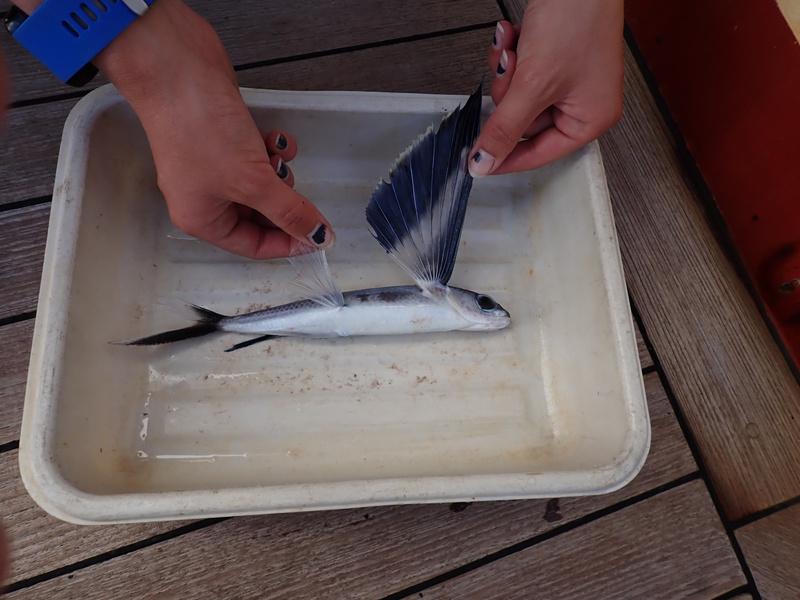
There were a few instances where we interacted with them more directly. One day, we accidentally injured two birds by hauling on lines we did not realize they were perched on They had been sitting aloft on the wheel where the lines are pulled through and were caught in the block for a moment, but escaped. We noticed one lost a section of feathers from its wing, and another had an injured foot. I wondered whether those injuries could be fatal if they made fishing or sleeping more difficult, or caused an infection. We saw both birds seeming to behave normally enough for some time after that. Especially
at night, before hauling on a line some of us took up the habit of jiggling them first, trying to warn any unseen birds.
On another evening, out of curiosity some of us approached and petted a booby who was perched on the quarterdeck. A little line formed of people eagerly waiting their turn to meet our celebrity friend.
cont'd >
A flying fish that landed on the deck, prey often eaten by red-footed boobies and other seabirds
The status of seabird populations varies by species, but globally seabirds are identified as the most threatened group of birds.
Unmoving, it allowed us to touch its wing feathers. It was strange and exciting to interact with the bird, though I later worried whether we could have caused harm. Boobies are known for appearing unalarmed by proximity to humans, but they are not our pets As with other animals, sometimes our desire to see them and interact with them, even when well-intentioned, can result in the opposite of what they need.
The status of seabird populations varies by species, but globally seabirds are identified as the most
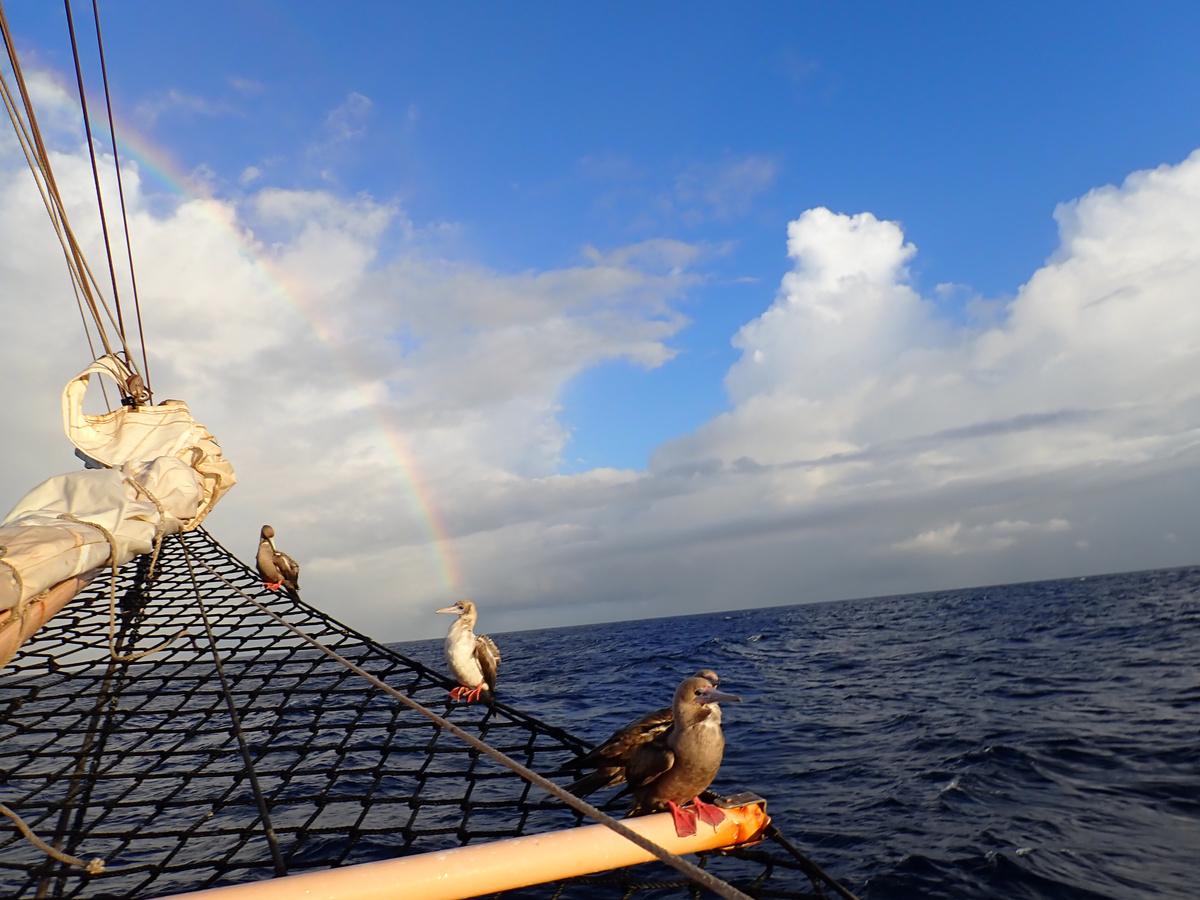 by Mallory Hoffbeck
by Mallory Hoffbeck
threatened group of birds They are vulnerable to many environmental issues, including habitat loss, disturbance from human activities like overfishing or land development, disease, pollution, invasive species, and extreme heat caused by climate change Yet the IUCN Red List reports that red-footed boobies are a species of “least concern” for population decline, meaning that though their population has greatly declined, they are now considered relatively stable and unlikely to become extinct in the near future.
>
cont'd
Red-footed boobies perching on the headrig
The other species we saw vary from “least concern” to “vulnerable ” Boobies appear to benefit from conservation efforts like terrestrial and marine protected areas, especially in Hawai’i and other areas of the Central Pacific, which can help to lessen human activities where they hunt and nest
by Mallory Hoffbeck
Further Reading
IUCN Red List Red-Footed Booby https://www iucnredlist org
Phillips, Richard A , Jerome Fort, and Maria P Dias “Conservation status and overview of threats to seabirds” in Conservation of Marine Birds, 2023, pp. 33–56.
E A Schreiber, R W Schreiber, and G A Schenk “Red-footed Booby (Sula sula), version 1 0,” In Birds of the World, S. M. Billerman, ed. (Cornell Lab of Ornithology, Ithaca, NY: 2020): https://birdsoftheworld org/bow/species/refb oo/cur/introduction

ISSUE 2, 2023
Life Lessons from a Booby
rom my post at forward lookout, I could only hesitantly look back up at the yards for fear of an unwanted substance shooting down right into my eye A group of redfooted boobies, the number of which we’ve lost count, had taken up residence in the rigging, with their line-up of cloacas aimed right at me. They were a comical kind of nuisance, turning the foredeck into a fishy-smelling, monotone Pollock painting. But they could never be only that, because what other experience in any of our lifetimes will allow us to call seabirds our shipmates?
Going to sea always teaches me something I never expected to learn, and I am privileged to be able to call these boobies my teachers. While watching them, I considered what it means to be a scientist, an environmental advocate, a human occupying space in the natural world, and a flawed individual always working to be a better person. The
boobies had no hard answers to any of the existential questions we are all bound to ask while alone with just the birds and our thoughts at forward lookout, but they certainly inspired in me some new ways of thinking and a few ideas.
cont'd
F
by Rebecca Cox >
Firstly, coexistence starts with the little things. You might not even think much about the small, easy changes that make your life easier, and that impose less upon the natural environment The boobies didn’t have to leave for us to resume unbothered lifestyles on board the Seamans. The idea of our coexistence occurred to me as we moved our galley mat cleaning operations from the foredeck to the quarterdeck, outside of the line of fire from the boobies. We still got clean galley mats, and the birds didn’t have to be disturbed by us cursing them for pooping on that spot we had just cleaned Similarly, watchstanders started wearing foulie jackets to lookout: no poo on our clothes or arms! The boobies became part of our life at sea, and there were eventually far fewer mumblings about needing to get rid
of the boobies who were making our deck inhospitable We all have it in us to adapt. It’s us in their home, after all.
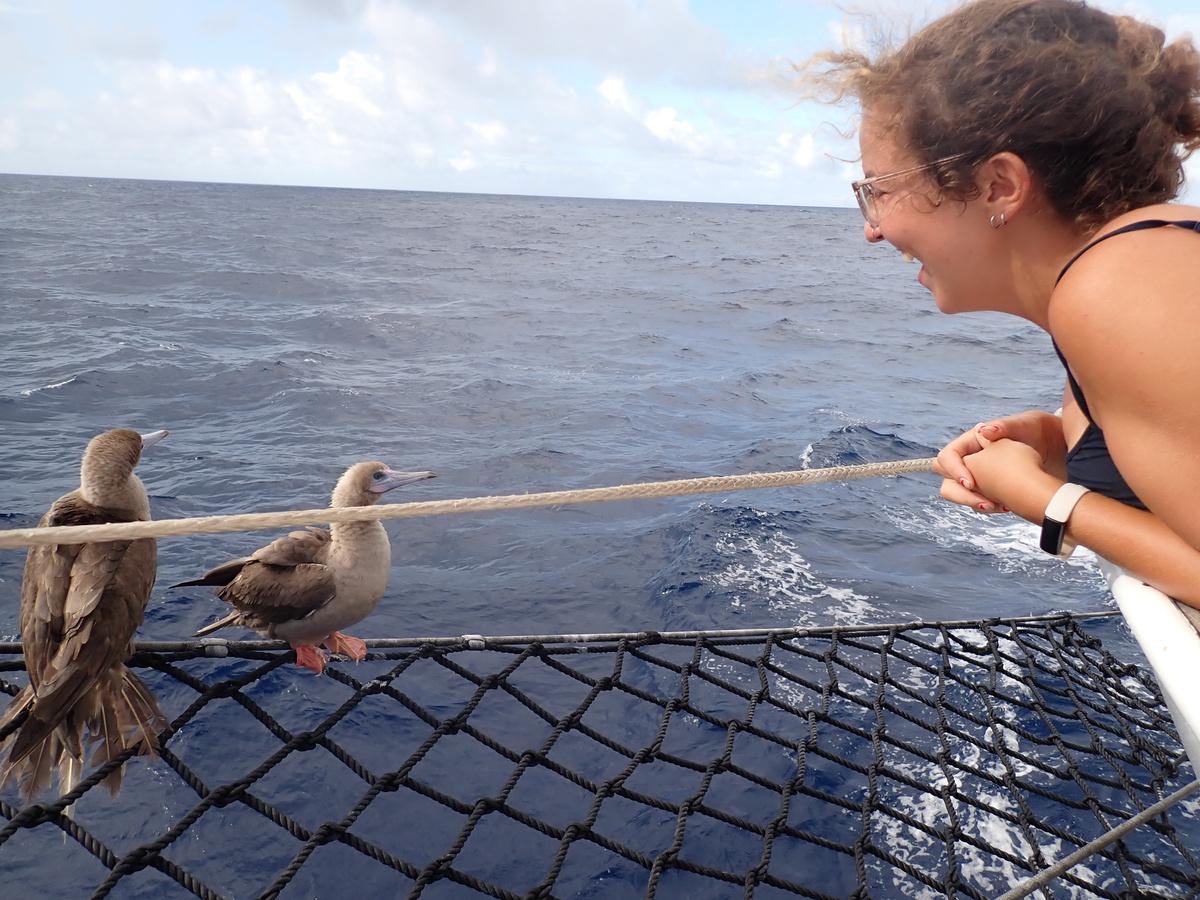
Secondly, while we are asking challenging contemporary research questions, we are still rooted in the history of science and its fundamental methodologies When I stand at lookout and watch the world, I feel connected to the people who came before me, who didn’t necessarily have advanced laboratories and equipment, but who made observations and found patterns among them to draw
by Rebecca Cox
conclusions about the environment.
I can see a dark shape high up in the sky, soaring in lazy circles without flapping, and know it is a frigatebird.
I know a tern from the way it flies, like it’s dancing and from its squealing voice. The boobies will sometimes skim the water, almost like a shearwater, but distinguish themselves when they rise back up above the horizon on flapping wings. They all speak to each other when one of them spots a fish. And the boobies, accused of being so clumsy and stupid, can unhesitatingly step off the headrig or the yards onto
cont'd >
Deckhand Becca Cox meets our surprise shipmates
unfurled wings with a compelling amount of grace and trust in the wind to carry them. We are learning about seabird identification, communication, diet, and aerodynamics without a class or textbook: there is so much we can learn just from observing the world around us
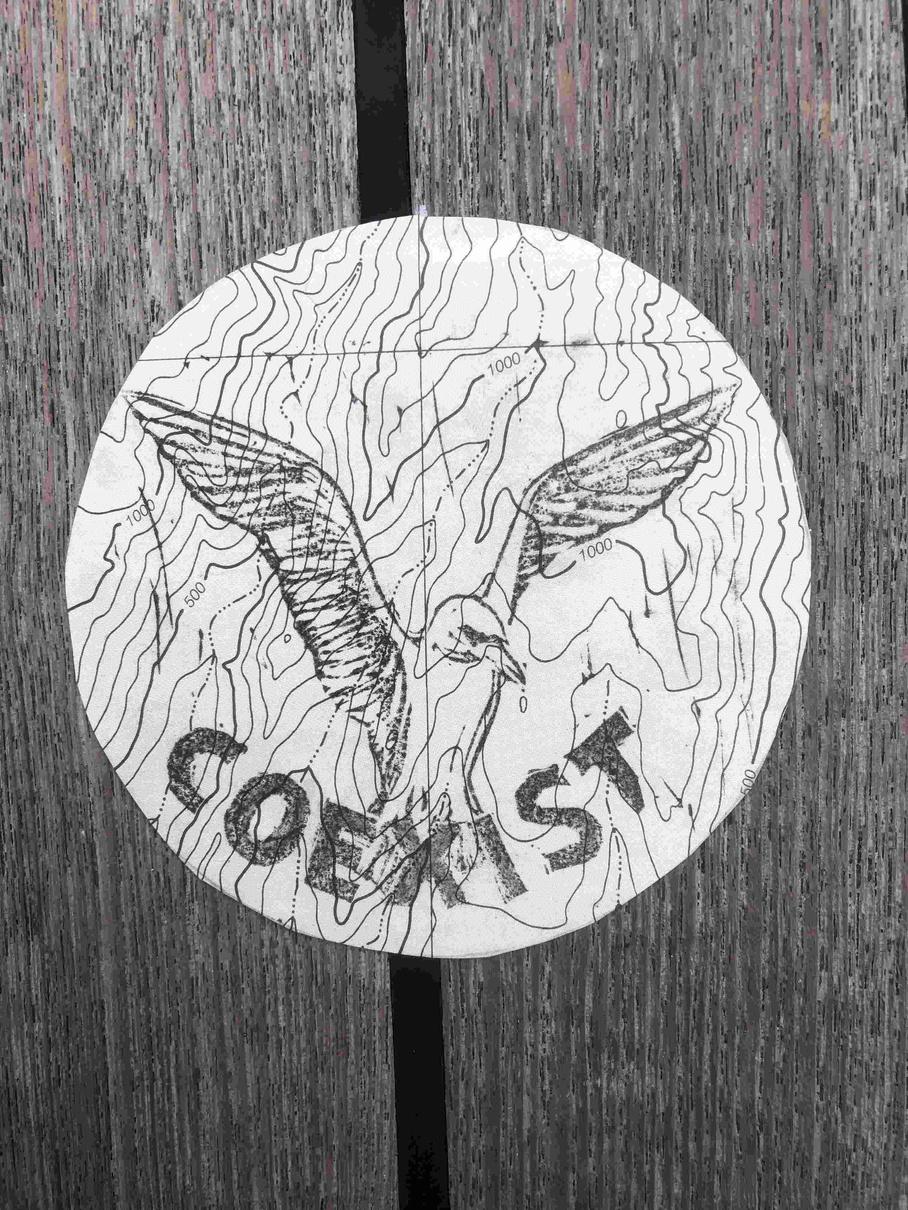
our conservation efforts. We can’t know them all the way we know our friends and family and neighbors,but we can recognize their sanctity. When I first made eye contact with a booby, one sitting just a foot or two away from me on the headrig, my first feeling was discomfort. In this moment, I could see that there was someone behind the eyes, looking back at me. I think that I was unprepared for this realization. Here was an individual that I was
Thirdly, animals are individuals. It’s easy to treat animals that we don’t often interact with as some obscure group, recipients of vague claims such as, “the seabirds are in danger from climate change!” But that can increase the distance between us and the animals we need to work to conserve. Seabirds, especially those far out at sea, are hard to study, because humans aren’t familiar with them; we can’t keep them in zoos, and they aren’t exactly cuddly-looking mammals (though they do look pretty soft and fluffy sometimes). But I can assure you, every booby, and every seabird and other animal, has a unique personality and consciousness

respect
by Rebecca Cox
that deserves the
and decency of
cont'd >
We all have it in us to adapt. It’s us in their home, after all.
“Coexist” badge print (Rebecca Cox)
connecting with. I wonder if she will remember me the way I remember her.
And lastly, I thought on lookout, we should question ourselves and the way we live. By watching how other animals behave and interact, we can challenge our own norms. One of the boobies who had moved onto the headrig was a bit of a bully, loudly scaring everyone else away. Nearly everyone on board presumed that this territorial booby, named “Skinny-Necked Richard,” was a male, likely based on our societal perceptions of human males or the behaviors of other male animals. But we may have fallen prey to gendered expectations: I discovered while reading a field guide that males tend to make more of a whistling sound, while it’s the females who more often have loud honking voices
Though we cannot confirm the sex of Skinny-Necked Richard (Deborah?), I appreciated the reminder to challenge my expectations: an individual is not bound to occupying any one role within a relationship or society (human or other). Furthermore, the boobies inspired me to consider shame management, which is something I am working on, especially as a very clumsy person living and working aboard a constantly-moving ship. The birds regularly stumble over themselves; some have even fallen out of the headrig or flown right into
by Rebecca Cox
it, and more often fail to land than land successfully Yet they are unphased! They just try again, or move on to some other activity. What would our lives be like if we spent less time feeling or dwelling on shame?
What would it be like to be a booby?


How to treat Marine Invasive Species Like a Doctor
veryone gets sick: sick with the flu, the common cold, and most recently the coronavirus. In Western society when we get sick, most will go to the doctor and are given some treatment to get our bodies healthy again. Unfortunately, we have been making our oceans sick by transporting the ‘germs of the ocean,’ invasive species, all over the world by ship Fortunately, like doctors, we have created various treatments to help protect our oceans. Here is how to treat invasive species like a doctor.
First let’s be a bit more specific. Everyday cargo ships travel across the world’s oceans delivering nearly every item that we use daily. To ensure that these ships have safe passage, they have something called ballast. Ballast is added weight in the hull of a ship to help add stability while the vessel is underway. A variety of materials and practices are used for ballasts. In the 19th
by Samuel Barresi
century it was common practice to fill the hull of your ship with corn, seeds, or grain that would be helpful once you arrived in new lands. In the 20th century ships began to use a wider variety of material like mined gravel or rock that was carefully placed inside the hull These materials would eventually get dumped outside the entrance of the harbor causing a whole slew of issues beyond invasive species.
Nowadays water is used as ballast on large ships. There is a near endless supply for large ships, like cargo and cruise ships; plus it’s free. A ship simply needs to pump water into the tanks when needed and in turn discharge the same water once the trip is over, adjusting based on how much cargo it takes on. This sounds spectacular; you may think all our problems are solved.
WRONG!! This unfortunately causes all sorts of problems. So let’s think, pause, think hard, open your minds to the world of possible issues that could arise.
Ready?
Awesome. Let’s take a ship called S.S. Germ starting in Hong Kong
cont'd >
E
ISSUE 2, 2023
carrying cars to Honolulu, Hawai’i, and therefore has all the weight of their cargo to help stabilize the ship. Upon arriving in Hawai’i, S.S. Germ unloads all the cargo and now needs to take on weight to stabilize. So, S.S. Germ begins to pump water into its ballast tanks, therefore restabilizing itself for the coming voyage back home to Hong Kong. In Hong Kong S.S. Germ will be restocking its cargo holds to start another trip.
To do this it must discharge all the water that is currently being held in the ballast. By doing this the S S Germ is dumping all the
microorganisms, marine and terrestrial diseases, and possibly fish that were native to Honolulu into the Hong Kong harbor. This can cause grand changes in the native ecosystem, which can lead to death of native species and economic struggle for the newly contaminated harbor
Now there are several ways to help prohibit this from happening, just like there are many ways to keep us from getting sick. These methods are broken down into three broad categories: isolation, exchange, and treatment
 by Samuel Barresi
by Samuel Barresi
cont'd >
Figure 1 Ballast water life cycle: A ship has no cargo and therefore the ballast tanks are full -> Ballast water is treated through various techniques and sampled for containments-> loading the cargo hold and thus discharging ballast water (Sayinli, et al , 2022)
Isolation
When you catch a cold or the flu your doctor may tell you to stay home from work or school to not spread your illness to any other person. This is the general idea of isolation. Currently there are three accepted practices of isolation for ballast water treatment First is retention; this option is primarily for ships that do not have a large change in their total weight. Retention is the practice of keeping the water for an extended period; some ships can hold their ballast water for months, sometime years at a time This ensures that anything that was taken up when ballasting is dead and can cause little to no harm. The second option is return. This is the practice of only de-ballasting at its port of origin. For instance, the S.S. Germ could practice return if and only if the vessel could make it back to Hawaii to discharge its ballast, as that is where it originally took on water. Finally, the last method of isolation is reception Reception is the practice of discharging ballast to an offshore facility where the water can be safely processed and then returned to the harbor. Reception, however, is uncommon as these kinds of treatment centers are incredibly costly
Exchange
The second method that is commonly practiced is exchange.
by Samuel Barresi
Exchange is based on the idea that the microorganisms and other diseases cannot survive in the deep ocean because the water has a different make up of temperature, salinity, and other chemical compounds thus causing no detrimental harm to the ecosystem. Similar to isolation, there are three main techniques for exchanging your ballast water. Please note that for each of these methods the vessel must be in water that is 200m deep and 200nm from any land as to ensure the most effective neutralization of any foreign bodies being discharged into the environment. First is the sequential method; in the simplest terms sequential exchange is the process of emptying the current ballast water and refilling the tanks with replacement sea water; for this technique to be effective, ninety-five percent of the ballast water must be exchanged. The next method is dilution: new ballast water is pumped into the top of the tank while existing ballast water is simultaneously discharged at the same rate. Therefore, in theory there is little to no water level change, hopefully keeping the ship as safe and stable as possible during the exchange For this method to be effective, at least three times the volume of the tank should be cycled. Finally, the ship can practice the flow-through method. This method
cont'd >
occurs through a process by which new water is pumped into the tanks allowing for overflow into an array of other chambers. Again, at least three times the volume of the tank should be overflowed to be considered effective. There are many regulations surrounding these exchange techniques as they pose the most risk to possibly contaminating a given region. For example, in Hawai’i it wasn’t till 1972 when the introduction of snowflake coral via ballast water decimated the local ecosystem as this invasive species monopolies food, space and various other resources did regulations begin to get put in place. In 2007 the Hawaiian administration adopted more strict policies to regulate ballast water discharge. More specifically vessels that practice water exchange must do so in water that is more than 200 nautical miles from any coast. As of 2007, any exchange methodology must be approved by the United States Coast Guard (USCG) if entering a US port The policy also states that the captain is responsible for the safety of the vessel and its crew. Therefore, if at the present time of a potential exchange the captain can determine that the technique could impose too much unnecessary risk, they can take the appropriate steps to not only mitigate risk but also exchange in waters less than 200 nautical miles from a given coast. Because of the hazards of exchange far from
by Samuel Barresi
port, onboard treatment methods are preferred over exchange, in order to prioritize the safety of the cargo, the ship, and its crew.
In Hawai’i it wasn’t until 1972 when the introduction of snowflake coral via ballast water decimated the local ecosystem.
Treatment:
These methods are like the Personal Protective Equipment and medicine given to you by a doctor to protect yourself from and treat whatever is ailing you. Similarly to how you would wear a mask to prohibit any unwanted pathogens from getting into your body, a filter can be placed on the intake of the ballast tanks to stop any large debris from entering. This is called filtration. Over time finer meshes and other methods have been developed, which have increased the effectiveness of filtration as original screens allowed for microorganisms and small sediments to pass through. Certain filtering methods work like hydrocyclones. (As water swirls around in a cone formation, hydrocycolones utilize gravity to pull heavier particles to the bottom, allowing for the clean water to leave out of the top of the filter.) These are far less efficient when used alone, however. Many ships have a cont'd >

series of filters (differing in technique) that will over time filter out micro-organisms and other unwanted particulate, leaving only clean sea water to enter the ballast tanks. Many times filtering is preferred over other treatment methods, as it is completely ecofriendly, unlike others, such as chemical treatments.
everything. However, due to the presence of bromide in salt water, a chemical reaction occurs, making the treated ballast water unsafe for discharge back in the ocean. Peroxide, specifically hydrogen peroxide, uniquely infiltrates the cell membrane and harmfully reacts with inner cell structures, thus quickly eradicating any living cells. Fortunately, hydrogen peroxide is a naturally forming compound, so there is little to no environmental effect. As hydrogen peroxide breaks down it simply becomes H2O, therefore no pollution

In the event that the mask you were wearing didn’t keep out all the germs and you by chance get sick, then your doctor may prescribe you with some medicine, like antibiotics, to fight your illness. Chemical treatments operate very similarly; this method focuses on killing or neutralizing any microorganisms that are in the tanks after water has been taken on. It is unlikely that they eliminate all organic material, but the grander issue with these techniques is the added pollution that can occur when the water is released back into the ocean. Typical chemical additives, such as ozone and peroxide, are highly effective in disinfecting the water in two very different ways. Ozone merely kills
by Samuel Barresi
Finally, the last treatment method is used like radiation to treat cancer; where we bombard the water with either Ultraviolet (UV) or Ultrasonic radiation. Ultrasonic radiation, or more simply put, sound or other vibrations have ultrasonic frequencies (20,000+ Hz) that cause the formation and rupture of microscopic air bubbles. As these bubbles pop they act like explosions, ripping apart cell membranes and effectively killing them. UV Radiation, on the other hand, causes a photochemical reaction in the nucleic acids of the organisms; thus, rendering them functionally unable to survive. The effectiveness of these techniques is directly linked to the size of the organism and the chemical makeup of the water; each should be tuned for the makeup and taxonomy typically found in the area. Another treatment method, cont'd >
As we departed Oahu, we saw this tanker that was nearly empty, “in ballast”
and the simplest of the techniques, is heat, raising the temperature of the water just like the body heats up with a fever. All organisms have a certain temperature threshold that they can survive, particularly marine organisms that are surrounded by a semi-constant temperature depending on the location Therefore, by increasing the temperature of the ballast water beyond the point that most organisms can survive, you can effectively kill everything in the water. However, it is wildly impractical to heat the immense volumes of water in ballast tanks (and expensive). Therefore, if this method is used, heat is typically extracted from existing systems on the vessel already, like the engine. Guidelines like the ones that Hawai’i have put in place, have been implemented all over the world to sustain the native ecosystem. However, there are many developing countries that lack the resources and capacity to put forth the necessary bandwidth to enforce any sort of policy that would protect their waters when ships enter their waters. Fortunately, organizations like Globallast are there to help address the global threat to the world’s oceans and assist developing countries in reducing the transfer of aquatic invasive species. Hopefully as time goes on the transfer of
organisms and pathogens by way of ballast water can be eliminated Until then we will continue to treat invasive species like doctors.
 by Samuel Barresi
by Samuel Barresi
Further Reading
Marlos De Souza, “Ballast Water,” Unconventional Water Resources, Manzoor Qadir, et al eds (Cham, Springer Nature Switzerland: 2022): pp. 213-29
Burcu Sayinli, et al “Recent Progress and Challenges Facing Ballast Water Treatment – A Review,” Chemosphere 291 (March, 2022): doi: 10 1016/j chemosphere 2021 132776

Plastic in the Pacific: From the Depths of the Ocean to Shores Seen By A Few
top of my mind on this trip: plastic.
ave you ever heard of Jarvis Island? How about Palmyra or Rose Atoll or Howland and Baker Islands? Kure? These are all islands and atolls in the remote Pacific Ocean, mostly uninhabited and rarely visited by much other than seabirds. These are places that few know about but those who do likely have a great deal of interest in. Anyone who’s heard of these islands is likely to be a mariner, military service person, or conservationist.
When I boarded the SSV Robert C. Seamans in Honolulu, Hawai’i and heard that we were heading to Howland and Baker Iislands, I was beyond excited. I knew we were about to be sailing into waters seen by very few people. But as we prepared to leave my home state of Hawai’i and embark on a long remote ocean crossing, I watched the wrapper of one of our crew members’ covid tests blow off the dock into the water This reminded me of what was going to be on the
I’m writing this article, finding myself once again in an extremely remote part of the Pacific Ocean, sailing towards the cross section of the equator and the international date line. So far we’ve seen an occasional plastic jug, water bottle, oil container and slipper float by, some debris with significant amounts of marine life such as barnacles growing off the sides. Many of these pieces of plastic have been floating for months with the currents of the ocean, numerous
As we prepared to leave my home state of Hawai’i and embark on a long remote ocean crossing, I watched the wrapper of one of our crew members’ covid tests blow off the dock into the water.
signs of humanity slowly traversing parts of the world seldom viewed by human eyes. Unfortunately the islands and atolls in this region of the ocean accumulate plastic debris
by Noah van Aardenne

H
cont'd >
ISSUE 2, 2023
from far off corners of the world, as well as from the fishing vessels and cargo ships who don’t properly handle their rubbish.

One small piece of plastic, say a wrapper from a covid-test, may seem somewhat inconsequential. However, there are many tons of plastic floating on the surface and sunken to the bottom of the ocean. This is something I observed myself last time I was in this part of the Pacific, on Palmyra Atoll. You may not expect there to be much if any pollution on the beaches of an uninhabited island that’s hundreds or thousands of miles from any major land mass, but there is actually quite a bit. On the shores of Palmyra I frequently observed piles and mounds of plastic building up on the beaches with the incoming tides. I saw oil jugs with writing in numerous different languages, likely from fishing boats. In addition to oil jugs there were hundreds of buoys, massive tangles of net and rope that once served as FADs (fish aggregating devices), plastic drink bottles and jugs, and once even a large low-profile drug smuggling boat with nobody on board, a craft that likely floated all the way from South or Central America and found its way to the remote shores of Palmyra Atoll.
Suppose we follow a hypothetical journey of the covid test wrapper that blew off the dock in Honolulu. It first gets swept out to the open
by Noah van Aardenne
ocean with the outgoing tide, floating along at the surface From there it gets caught in the currents of the North Pacific Subtropical Gyre, drifting along until a fish eats it, mistaking its reflective surface for the scales of a smaller prey fish After this fish consumes the plastic wrapper, the animal begins to get sick and as a result is slower than the rest of its fellow fish. This slower fish is an easy target for a seabird such as an albatross, who is constantly on the prowl and hunting or fish from the skies above the ocean. As a result of over-consumption of plastic, this albatross may retreat to its island or atoll of choice and end up succumbing to injury or malnutrition due to
cont'd >
Noah watching the neuston net from the science deck
the plastics.
If the wrapper did not end up in an animal’s stomach, it might end up stuck in an endless cycle of currents and ultimately end up breaking down into microplastics. This happens when any number of factors such as sunlight and waves breaking onto rocks or the beach break the plastic into microscopic pieces. These plastic particles remain in the ocean and may end up inside the bodies of the tiniest of animals, bio-accumulating up the trophic level. Not enough research has been done on the effects of human consumption of marine life containing microplastics to make a definitive claim as to the issues it can cause.
On our voyage, we have caught many small particles of plastic in our net tows of the surface In an ideal world our tows would only capture the fascinating plankton, fish larvae, and other mysterious creatures of the ocean. The plastic samples we have collected will be sent back to SEA’s Plastics Lab for further examination
If that covid-wrapper doesn’t break down on the surface, depending a bit on the type of plastic, it could end up sinking to the depths of the ocean and settling on the seafloor in a corner of the world yet to be seen by humanity. Oftentimes the conditions on the seafloor are perfect for the preservation of plastics, resulting in the plastics
by Noah van Aardenne
remaining intact for decades or centuries, and ultimately accumulating. Little is known about the status of deep sea plastic due to the fact that humans rarely go to or send ROVs (remotely operated vehicles) to the seafloor; it’s a costly endeavor to embark on.
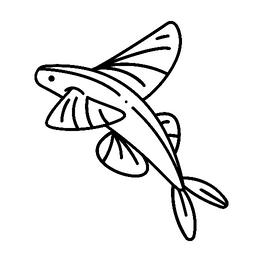
Seeing the impact of the carelessness and disregard for the environment displayed by so many people is truly disheartening. We all share these oceans with each other and an incredible diversity of animals. Many people living on islands and in coastal regions of the world rely on the ocean as a source for food or use it as a way to make a living. Often these people affected the most by our lack of care for the environment have contributed the least to the growing issue of plastic pollution It’s unfortunate that lately the focus of the media is issues that have no bearing over the environment or the world at large, unless there’s something that really gets people’s attention, like a bird covered in oil. Plastic pollution needs more awareness, otherwise little will be done to remedy it.
Further Reading
Law, Kara Lavender, 2017. “Plastics in the Marine Environment,” Annual Review Mar Sci 9, 205229 doi:10 1146/annurev-marine-010816-060409
What We Can Do for the Health of the Central Pacific Ocean
After studying and traveling in the Central Pacific Ocean this past summer, the students and crew of the Robert C. Seamans proposed actions we can take for the health of the people and marine life of this region The following actions are the result of our ship’s vote
As individuals we can…
·Educate yourself and do research about the Central Pacific to better understand the issues articles, books, podcasts, interviews, fiction, music, art
·Vote for representatives who support environmentalist policies

·Eat and buy responsibility: eg. eating sustainably-caught seafood, buy products with less plastic packaging, and shop locally
We want companies to…
·Prioritize green infrastructure and divest from fossil fuels
·Improve their standards and enforcement for greenhouse gas emissions Work more equitably with the communities they employ or sell to
·Keep the environment as a stakeholder in the company
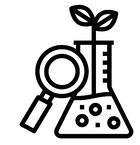
We want our governments to…
·Enforce fisheries regulations in the Central Pacific via AIS, observers, and other means
·Enforce emissions regulations in the private and public sector in their countries and on the high seas
·Meet declared goals from the Paris Agreement and other international treaties
If we had money to donate, we would give to organizations that represent these sectors...

·Green infrastructure development and waste management for low-lying island states
·Local organizations

·Educational organizations


We want to support further research especially on… Alternative energies
·Sustainable transportation technologies, including greener shipping

Icons from thenounproject.com ISSUE 2, 2023
Coda The Dissonance
There is something about living on a ship that makes you hyperconscious of the impact of your life. Hand washing each plastic candy wrapper, logging the weight of leftover scraps of food, physically feeling the heat of the engine room on boat checks--each degree a reminder of the material burned to produce our energy--you are intimately aware of what you consume and what you create.
Our modern world, in many ways, is designed to dull this awareness: to make food, clothes, music, garbage, electricity--in short, every material aspect of our lives--a black box, sleek and unobtrusive, revealing nothing about where they come from or where they will go once we are through with them. So it is unsurprising that, upon our return, the world overwhelms. Ostensibly, we are traveling home; yet our reactions are those of tourists, bewildered and lost in an unfamiliar land The world we return to is frantic with notifications, blaring with sound, barking prices and sales and CHEAP-FAST-EASY from every screen and storefront. Products sit, still and airless, inside layers of plastic; lights stay on in empty rooms and blaze down upon empty streets; air-conditioning whirs from every corner.
Still, as uncomfortable and jarring as it can be, there is also something almost reassuring about the dissonance we experience. This is what it says: What was “normal” has shifted You are capable of imagining something different.
And make no mistake: “something different” is necessary.
The area in which S’310 sailed, though far removed from the countries contributing the bulk of carbon dioxide to the atmosphere, is one of the most affected by the impacts of climate change. Sea level rise has already had a devastating effect on the thousands of small low islands scattered throughout the Pacific. Innumerable layers of history and culture, accumulated over centuries by Pacific Islanders and integrally connected to the land, risk being washed away.
Furthermore, the species entwined with these cultures--from the seabirds soaring above the waves to the whales, sharks, and tuna deep below--all face, to varying extents, the pressure of species extinction. Whether caused directly by overfishing, habitat loss, or more complex ecological changes, the extinction of these species threaten to redefine the Pacific as it has appeared to generations of inhabitants, human and nonhuman.
ISSUE 2, 2023
cont'd >
On the sea, any other sign of human life becomes a novelty, not a rule: the passage of even an airplane overhead brings the lookout back to let the people on the quarterdeck know. It is easy to feel that we are no longer part of the world But on land, we do not have the luxury of that illusion. We impact, and are impacted by, the movements and choices of billions of other people.
So when we think about environmental problems, it is easy to feel that the impact of our individual lives--the lights left on, the plastics used, the ballots cast--is negligible. The forces at work seem colossal, the issues complex to the point of incomprehensibility--and when problems operate on that scale, the work done to try to solve them feels proportionally minuscule. It is easy to believe that we are powerless-that the only people who can impact the future are presidents and CEOs.
But it is, in fact, our duty to resist this belief. Those who do not care for the future of the planet welcome pessimism, welcome the sentiment that environmental degradation is inevitable – it makes their work easier, their actions as blameless as entropy And despair, however tempting, remains an illusion. It assumes a black-and-white future, a binary question of “sustainable” or “doomed.” And this is not the case. Despite the rhetoric of the headlines, there is no single point –no degree Celcius, no percentage of species lost, no ton of plastic
created--past which the world becomes unsaveable. Everything counts.
So, however brief the dissonance may be, it is worth savoring. This is environmental work, too, just as much as research and policymaking: simply noticing the places where our lives could be different. Change is possible; it is necessary; and it begins, always, with the dissonance between what is and what can be.
– Julius Gabelberger

ISSUE 2, 2023
Sam Barresi is a senior studying mechanical engineering at Merrimack College He hopes to continue to be a part of the SEA community and help improve sea life with fun and creative projects

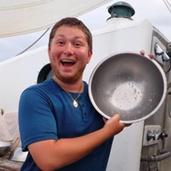
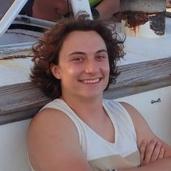
Elijah Busch Elijah Busch is a junior at Oberlin College studying Neuroscience and Psychology Hailing from Wilton, Connecticut, Elijah's journey is guided by his closeknit family two dads and a cherished grandma who anchor his life with love and support.
Allie Cole is a visiting scientist, and SEA alum (S287), from the Rotjan Lab at Boston University and the Blue Nature Alliance She is studying the patterns of larval fish found in all the samples collected both on this trip and past trips She lives in Santa Barbara, California where she completed her masters in Environmental Data Science
Autumn Crow is a senior at Knox College, majoring in biology and secondary education She is from Colorado Springs, Colorado where she enjoys running, hiking, and reading She hopes to sail more in the future to teach young people the joys of sailing.

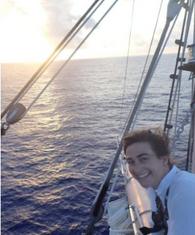
Caleb Fineske is a rising junior at Middlebury College where he is majoring in Environmental Policy and minoring in Spanish and is a member of the track team there He is from rural Texas in a small town called Hunt, where he lives on a summer camp.

Julius Gabelberger is a student onboard (at Kenyon College, majoring in Biology) She loves writing, and the sea, and writing about the sea. She is the #1 Ctenophore Defender onboard the Robert C Seamans Hannah Gerrish is an assistant scientist at SEA. She calls Alaska home when she isn’t at sea on tall ships and likes to spend her time in nature, crafting, and with friends, family, and pets
Abby Grassick is a recent graduate of Marine Science at Boston University and a visiting researcher from the Rotjan Lab on S310. When she is not identifying zooplankton, she likes to spend her time reading, hiking, and playing guitar

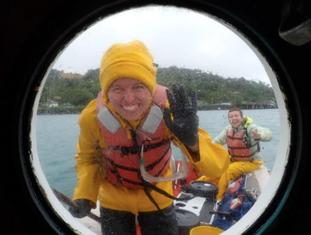
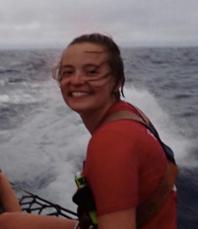
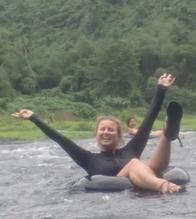
Mallory Hoffbeck co-edits this issue and was a teaching assistant for the “Conservation and Management” course This summer she graduated with her master’s in international environmental policy from the Middlebury Institute in Monterey, California.
Sil Kiewiet de Jonge is an SEA alum (C302) and holds a degree in Human Ecology from College of the Atlantic His homeport is Monnickendam, in the Netherlands His interests are ecology, music, languages, social justice, anarchist theory to name a few but perhaps the most important thing is the connectedness between them all
ISSUE 2, 2023
Rick Miller is a visiting professor and captain at SEA He recently retired as professor and dean of faculty at the Maine Maritime Academy Rick is a master mariner, with particular interests in meteorology and celestial navigation. Richard King co-edits this issue and was the instructor for the “Conservation and Management” course He’s a visiting associate professor at SEA and the author of Ocean Bestiary and Ahab’s Rolling Sea

Olivia Patrinicola is a student at the University of South Carolina studying Marine Science She is in her final year of college and is currently working in Dr. Claudia Benitez-Nelson’s lab processing sediment samples Olivia is from Williamsburg, Virginia where she lives with her parents, brothers, and her cat, Frankie
Hallie Rockcress is a recent graduate from Boston University, she received a BA in Environmental Analysis and Policy. She finished her college career at SEA and now lives and works in Portland, Maine and looks forward to learning more about the coastal regions of New England and the effects of climate change on local communities
Abby ten Broek is a rising senior at Smith College who is double major in French and Biology, and a member of the rowing team. Home base is in Arlington, MA, where she lives with her cat, her dog, and her parents After college, she hopes to spend as much time at sea and doing as much science as possible, focusing especially on seabirds and whales!
Blaire P. Umhau is a Visiting Assistant Professor of Oceanography and Chief Scientist with Sea Education Association. She earned her Ph D in Marine Science from the University of South Carolina, and her research interests include carbon cycling and marine radiochemistry
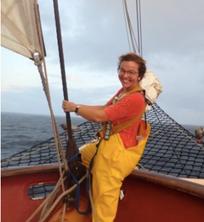
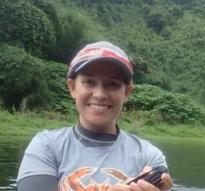
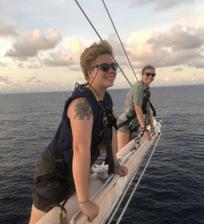
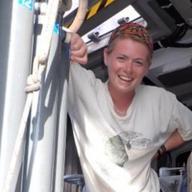
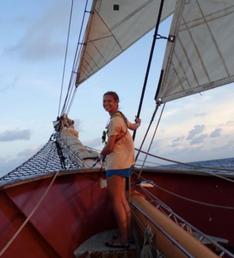
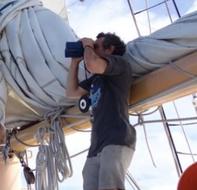
Noah van Aardenne is a student of aquaculture at the University of Hawai’i at Hilo While in college he has worked in aquaculture and conservation in the Pacific, including a restoration project on Palmyra Island Becca Cox is a deckhand and SEA alum (S299) from Falmouth, MA Her interests include the connection of art and culture to the changing environment, seabird biology and ecology, and artmaking with any materials she can get her hands on

ISSUE 2, 2023
The Crew
aboard the Robert C. Seamans Summer 2023--Hawai’i to PRIMNM to Fiji
Captain Rick Miller
of S’310
Chief Scientist Blaire Umhau
Maritime Studies Professor Rich King
First Mate Rocky Bonner
Second Mate Holly Graf
Third Mate Olivia Le Blanc
First Asst Scientist Supi Vallas
Second Asst. Scientist Hannah Gerish
Third Asst. Scientist Carly Cooper
Visiting Scientist Abby Grassick
Visiting Scientist Allie Cole
MS Teaching Assistant Mallory Hoffbeck
Chief Engineer Marshall Thomas
Assistant Engineer Duane Keohane
Steward Ashley Look
Asst. Steward Meredith Arlotta
Program Asst. Thomas Devereux
Deckhand Tadhg McKay
Deckhand Gabe Packer
Deckhand Izzy Lardner
Deckhand Emily Benson
Deckhand Sil Kiewiet de Jonge
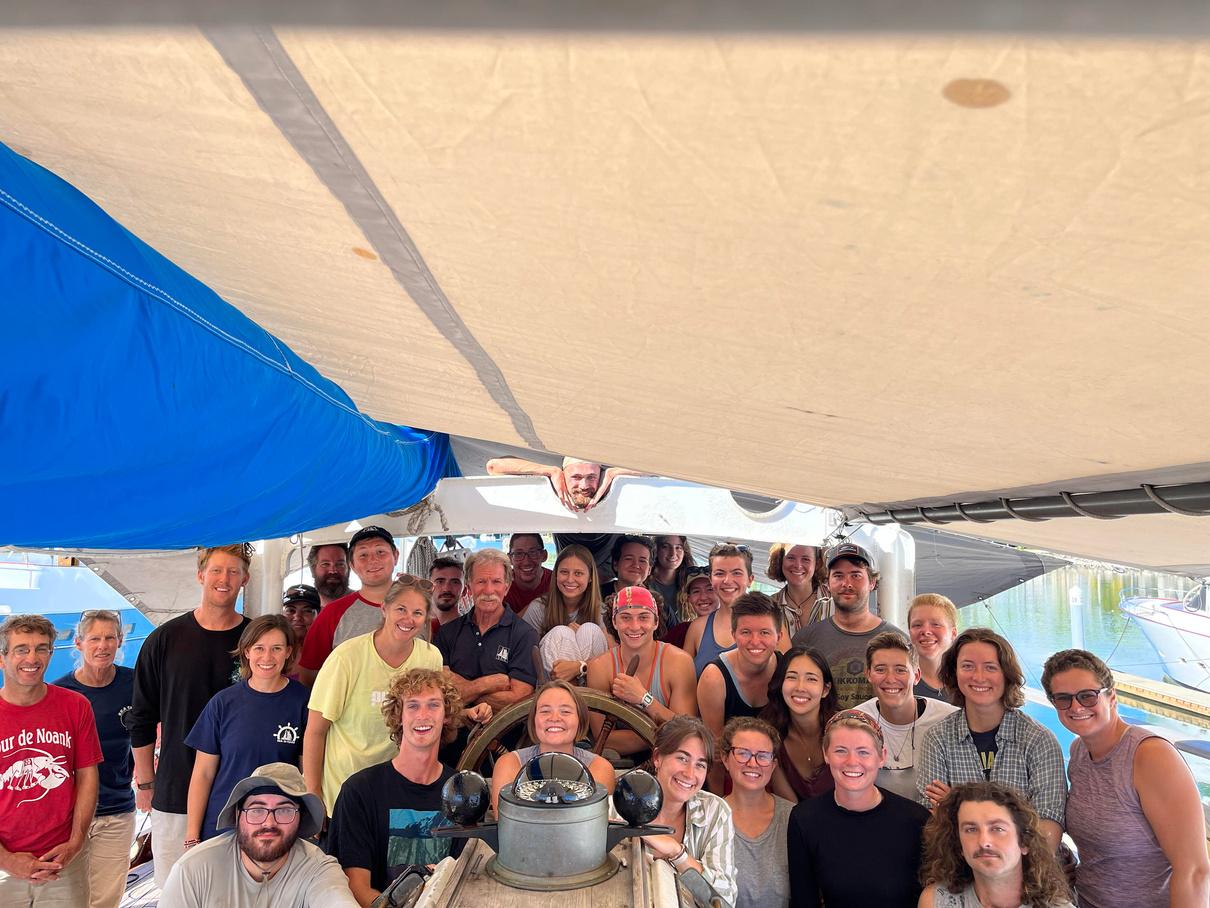
Deckhand Becca Cox
Deckhand Morgan Hayman
Student Caleb Fineske
Student Elijah Busch
Student Hallie Rockcress
Student Abby tenBroek
Student Sam Barresi
Student Autumn Crow
Student Julius Gabelberger
Student Noah van Aardenne
Student Olivia Patrinicola
ISSUE 2, 2023







 by Blaire Umhau
by Blaire Umhau
 by Rick Miller
by Rick Miller



 cont'd
cont'd
 by Olivia Patrinicola
by Olivia Patrinicola



 by Autumn Crow
by Autumn Crow




 by Hallie Rockcress
by Hallie Rockcress








 by Elijah Busch
by Elijah Busch



 by Allie Cole and Abby Grassick
by Allie Cole and Abby Grassick


 cont'd >
Painting by Julius Gabelberger
cont'd >
Painting by Julius Gabelberger

 by Julius Gabelberger
by Julius Gabelberger

 by Abby tenBroek
by Abby tenBroek





 by Mallory Hoffbeck
by Mallory Hoffbeck



 by Samuel Barresi
by Samuel Barresi




























